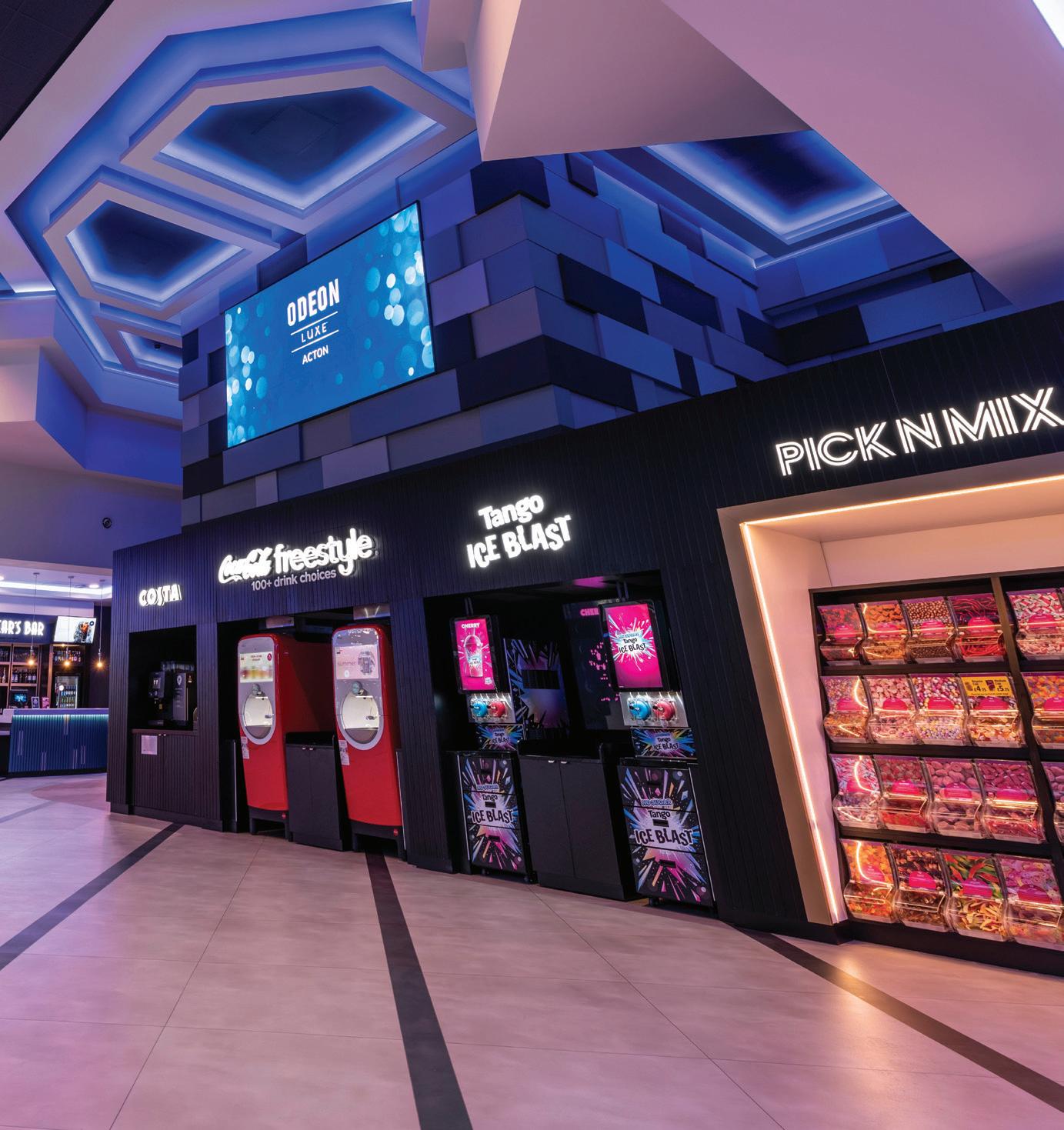CINEMA TECHNOLOGY









































The recent announcement shared by Cinema United (formerly NATO) that US exhibitors have invested more than $1.5 billion in improving their cinemas over the past year is reflective of an industry starting to focus on the future beyond operating purely in survival mode, something very much on show at Cine Europe in Barcelona where optimism and intent married together to create a genuine industry buzz not seen for a number of years.
The renewed commitment to the theatrical experience by major Hollywood studios along with greater certainty over content and an improving box office (up by around 5% versus 2024) creates a strong foundation for continued growth. That should be further backed up by a strong end to the year supported by releases such as Wicked: For Good, and Avatar: Fire and Ash which should help see 2025 comfortably eclipse 2024 in terms of box office revenue.
With that level of certainty and indeed positivity, exhibition finds itself at an exciting crossroads in terms of figuring out where to invest next, how to innovate and most importantly how to keep up with ever changing consumer demands.
Right now the overwhelming body of evidence and data suggests that movie-goers are increasingly demanding premium experiences. A few years ago "premium" might have meant a PLF such as IMAX or Dolby Cinema or even just recliner seats but it's clear movie-goers want it all, they want something different to the home, and they want it available to them in quantity. That's why exhibitors such as Cinemark has recently invested in 20 new ScreenX auditoriums whilst across the Atlantic, leading operator Vue has launched its own PLF brand EPIC, powered by Barco’s HDR solution. Premiumisation outside of PLFs might once have meant luxury seats, it now means an experience supported by technology and specially mastered content.
There are many options available to exhibitors right now and over the next eighteen months, it’ll be about making informed choices and investing wisely to drive revenue opportunities and reduce operating expenditure all whilst cashflow remains challenging.
With that in mind, in this edition we take a look at some of the technologies that might drive those premium experiences and help create different and possibly better experiences. From quality control measures and imaging technologies through to opportunities to reduce carbon footprints with automation, CT Magazine has you covered.
And in the short term, with a very strong end to the year predicted, we're currently receiving requests for advice on how to prepare for Avatar: Fire and Ash. CTC is working on a comprehensive document to support the exhibition community, but in the short term, start your planning now to ensure you’re cinema is ready to welcome audiences. We recommend carrying out (or work with your integrator) a thorough QA on all hardware, from 3D systems and projectors, through to lamps, speakers and screens now is the moment to ensure your cinema is operating at its peak and where necessary take steps to get those incremental improvements made before December.






























CTC PRESIDENT: RICHARD MITCHELL richard.mitchell@cinema-technology.com
ART DIRECTOR: DEAN CHILLMAID dean.chillmaid@cinema-technology.com
COMMISSIONING EDITOR: PETER KNIGHT peter.knight@cinema-technology.com
ADVERTISING: SANDIE CAFFELLE sandie.caffelle@ cinema-technology.com
SUBSCRIPTIONS:

NOTHING TO BE SCARED OF AS WE APPROACH SPOOKY SEASON
Comscore's Lucy Jones provides a compelling update in to the box office trends and looks forward to the end of 2025 and beyond. 22
REFLECTIONS FROM BARCELONA
A retrospective look back on this year's edition of CineEurope which blended together excitement, intent and purpose. 26
THE RE-INVENTION OF CINEMA OPERATIONS
A look at the new PAA40+ from CinemaNext which promises to help exhibitors manager their energy usage with automation.
8
US CINEMA OWNERS INVEST $1.5B IN THEIR THEATERS THROUGHOUT THE PAST YEAR
Cinema United unveils a report showcasing investments made by major US exhibitors.
13
CJ4DPLEX AND CINEMARK EXPAND RELATIONSHIP WITH NEW SITES
Leading US exhibitor Cinemark recently announced 20 new sites across the USA and Latin America.
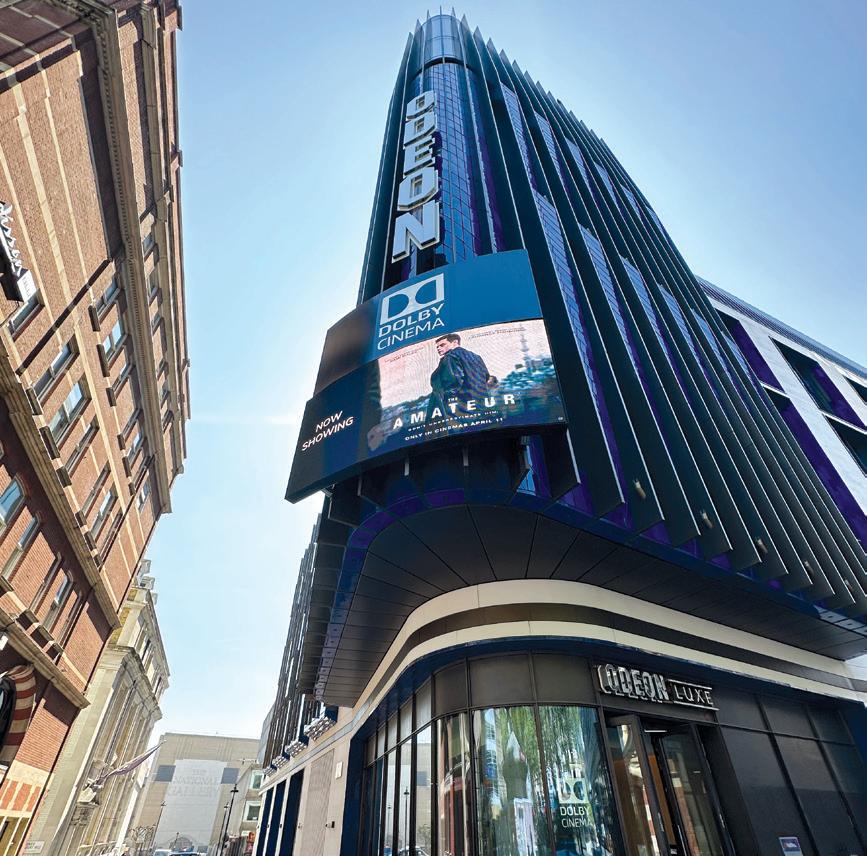
28
A NEW CHAPTER IN LIGHT MEASUREMENT
Peter Knight takes a look at the new low-cost HSG Labs Checker designed to help exhibitors and non-technical staff to measure light and sound. 30
LED'S GROWING SHARE OF THE PICTURE
For the first time in two years, we take an in-depth look at the state of the LED screen estate and where the technology might be headed. 36
YOUR QUESTIONS ON LASER PROJECTION ANSWERED
In the final part of our series on laser projection, Kommer Kleijn and Peter Wilson answer CT readers questions. 43
POST PRODUCTION: PART 3
In the final instalment of this unique series covering the Post Production process, Andy Quested looks at the future. 48
REEL INTELLIGENCE
Artificial Intelligence continues to evolve at such a rapid pace that we provide a snapshot of the latest developments. 50
AI COULD POPULARISE INTERACTIVITY ON SCREEN
Omdia's David Hancock takes a look at the potential capabilities of AI and how it might play a significant role in the evolution of content.
ROUTES TO NET ZERO
A look at the UK Cinema Association's ambitious and collaborative approach for sector-wide net zero.
SPOTLIGHT ON SATURN VISUAL SOLUTIONS
Having recently celebrated its 27th birthday, CT Magazine learns about one of the leading software and signage providers.















































































WORDS: RICHARD MITCHELL, PRESIDENT, CTC
Technical training remains critically important for cinemas given the reliance on technology to deliver a high-quality viewing experience and the changing skillsets and expertise of those operating cinemas on a daily basis. Education remains at the heart of CTCs mission and training courses are one of the most asked for resources by our community.
In late June and after a substantial hiatus, the CTC team delivered its Projection and Presentation Fundamentals course in London to more than 60 attendees with delegates attending from Italy, Belgium, the Netherlands and of course, the UK.
The course covered Picture and Sound Perfection, Testing and Test Materials, Measuring Screen Brightness, File Naming Conventions, KDMs, Accessibility, Event Cinema and TMS. For some, the course served as a reminder on fundamentals and a need for regular testing to ensure high quality presentation is maintained. whilst for others, it provided an insight in to areas of cinema operation that they may not have previously been exposed to. With incredibly positive feedback from all the attendees and significant demand, the CTC training team are now working on running another course in the UK and expanding the same
CTC EXECUTIVE TEAM
RICHARD MITCHELL (PRESIDENT), GRAHAM LODGE (VICE PRESIDENT), JOSEPH BOUTROS, JESSE CHOW, MIKE BRADBURY, SANDIE CAFFELLE, CHRIS CONNETT, MARK KENDALL, PETER KNIGHT, ADAM MACDONALD, SAUL MAHONEY, JENNIFER MORGAN, ANDRE MORT, MARKUS OVERATH, LOYS PHILIBERT, DAVID POPE, TONI PURVIS, ULF QVICKLUND, SIMON TANDY, KRISTINA WARNER, PAUL WILLMOTT.
offering to cinema professionals in mainland Europe in early 2026 in order to further support the industry.
The second half of the year is always a busy time for CTC. At CineEurope, CTC celebrated reaching the significant milestone of 1,000 members with its annual networking event with more than 200 industry professionals attending. Whilst in Barcelona, the podcast team recorded another episode of “In The Pub” with special guests Steve Davis from DCM and Amanda Rufener from PaperAirPlane Media talking about advertising, trailers and digital marketing.
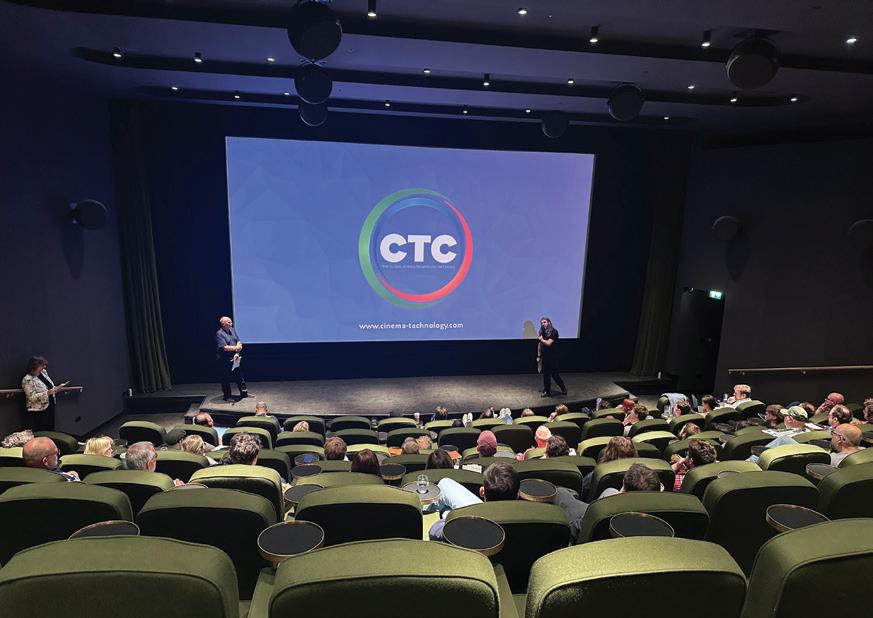
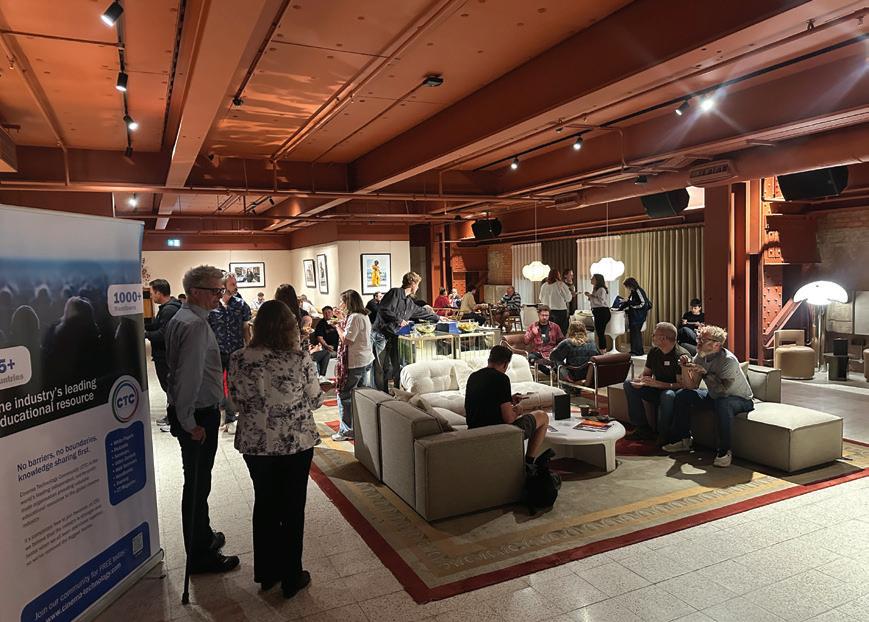
With summer now starting to fade, the team are turning their attention to supporting upcoming industry activities. In early November, the team will once again support colleagues at Film and Kino in providing more than 3 hours of technical programming for the Norwegian Cinema Conference this year held in Kristiansand and later in November, the team will support UNIC in
CTC ADVISORY COUNCIL
MARK CHRISTIANSEN (PARAMOUNT PICTURES), BRIAN CLAYPOOL, JOHN DOWSLAND, THERESA ENGLISH (TK ARCHITECTS), MARK DE QUERVAIN (INDY CINEMA GROUP), JAN RASMUSSEN (NORDISK FILM), DOMINIC SIMMONS (BFI), ALICE TENTORI (DIGIMA), JULIA VINOKUROVA (REALD).
providing further insights on Cyber Security at the Cinema Days in Brussels. Our support is also not just limited to Europe. As we turn towards 2026, CTC is strengthening its presence in the USA.We are delighted to welcome LA-based Jesse Chow (VP Content Management & Development, Theatrical Distribution Operations at Universal Pictures) to the Board of Governors. Jesse joins Kristina Warner in building out CTCs presence in North America as we seek to further support the industry in the coming years.
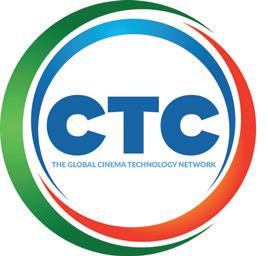
WORDS: DAVID POPE, PRESIDENT, IMIS
We welcome the UK Government's newly published Creative Industries Sector Plan which recognises the sector's economic and cultural significance.
What a summer it’s been for the International Moving Image Society (IMIS) - full of insight, innovation, and genuine connection.
A highlight for me was our recent event, Colour Truth: Metamerism in Cinema, in partnership with Dolby. Bringing together cinematographers, colour scientists, post-production experts and manufacturers. It was a powerful reminder of the magic that happens when diverse expertise comes together to protect creative vision and audience trust. Earlier this year, our Student Showcase in May sparked a surge of engagement from emerging talent, doubling student membership and strengthening links between new creatives and established industry leaders. As we look ahead, my commitment - and that of the whole IMIS team - remains the same: to keep building spaces, both in person and online, where creativity, technical craft, and collaboration can flourish.
Here’s to the months ahead and all the stories we’ll create together.

On 22 September, IMIS partnered with Dolby for Colour Truth: Metamerism in Cinema. This unique event, hosted by Pippa Considine, Associate Editor, Televisual featured stellar speakers including Mike Bradbury, Head of Cinema Technology, Odeon Cinemas, Mari Yamamura, Cinematographer and Industry Expert Peter Wilson on why colour accuracy matters, how to mitigate it and whether standardisation may be a way forward.
The event was a huge success, delivering practical
insights, sparking cross-disciplinary debate and reinforcing IMIS’s role as a bridge between creative and technical disciplines.
You can now watch the event highlights and full session recordings on movingimagesociety.net!
Since reigniting our social media presence, we’ve been creating more ways for our members to connect, share, and be seen in the industry. From event promotions and member spotlights to post-event highlights and exclusive interviews, our channels are now a yearround hub for keeping you informed, inspired, and part of the creative conversation — no matter where you are in your career.
› Engagement up: Meaning conversations are happening, ideas are being exchanged, and your peers are responding.
› Impressions up: Meaning more eyes on IMIS updates and more opportunities for your work and voice to be noticed
› Reach up: Meaning we’re connecting not only with members, but with key players across the wider industry.
We welcome the UK Government’s newly published Creative Industries Sector Plan which recognises the sector’s economic and cultural significance. The strategy aligns with our mission to develop skills, champion innovation and support industry growth on a national and global stage.
Not yet a member? Head to movingimagesociety. net to sign up.
CINEMA UNITED recently published a report which highlights that the North American exhibition industry has re-invested more than $1.5 billion in their theaters in the past year, demonstrating a financial commitment to creating the premium entertainment experiences that fans of movies on the big screen crave. This industry total includes re-investment of $920 million from the eight largest circuits in the United States and Canada. A year ago, those same eight circuits alone pledged their commitment to invest more than $2.2 billion to modernize and upgrade theaters of all sizes over a three-year period.
From Cinema United, the trade association representing nearly 64,000 screens worldwide, the Cinema Investment Report (available in full here) highlights the overall depth and breadth of these investments across the industry and the impact they have on communities of all sizes. From upgrading projectors, sound equipment, and screens (there are nearly 6,000 premium large-format screens worldwide) to adding dynamic food and beverage options (dine-in cinemas represent 10% of the North American box office), cinemas today sit at the forefront of the experiential economy, driving local business and providing positive financial growth for a myriad of industry partners, including construction, architecture, marketing and advertising, retail and dining. More than 100,000 jobs around the world are directly related to the innovation and investments highlighted in this report.
“Exhibition is a Main Street industry,” says Michael O’Leary, president and CEO of Cinema
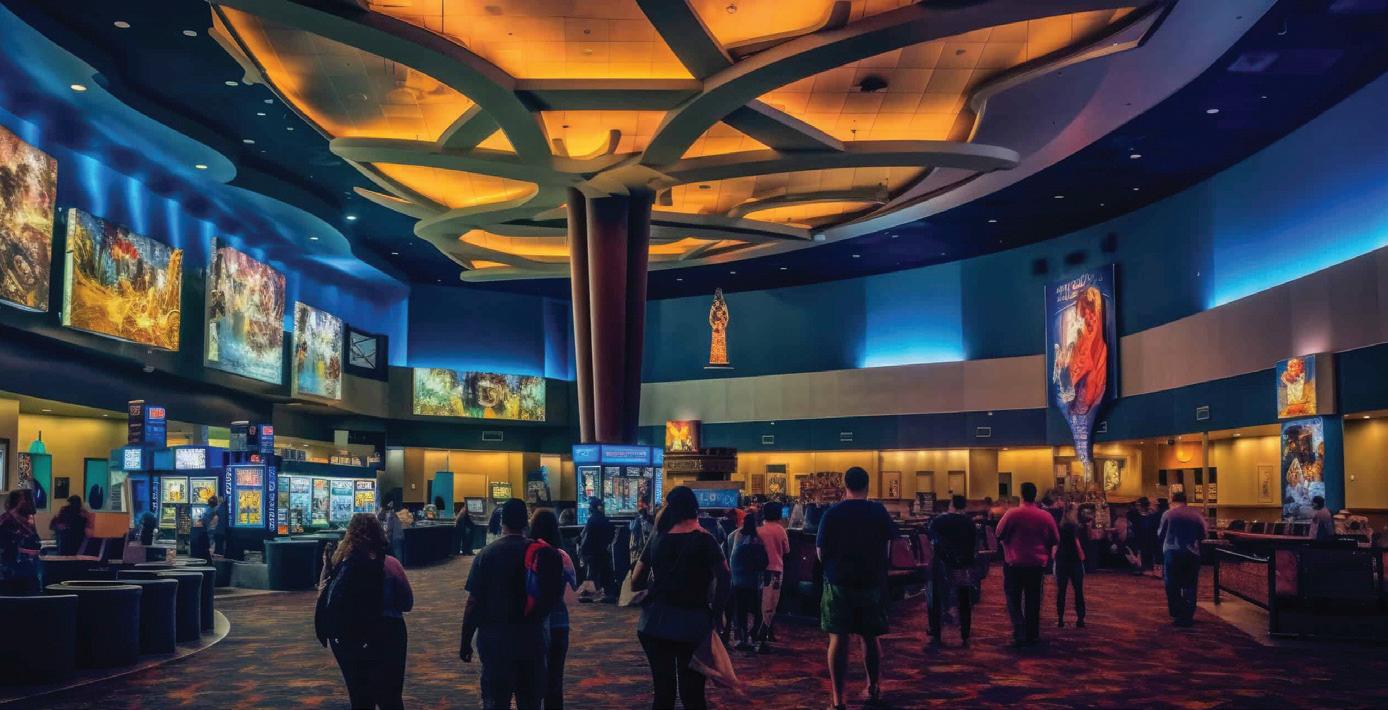
United. “Theater owners aren’t just re-investing in their facilities; they are investing in cities and towns of all sizes across the United States and Canada. The beneficiaries of this commitment will, of course, be movie fans of all ages but also local businesses and the talented contractors and craftspeople who help bring these renovations to life.”
In addition to showcasing the capital investments being made in theaters, the report also highlights the local vendors who led construction and renovation efforts that movies fans everywhere will enjoy.
“Movie theaters provide an unmatched entertainment experience for people around the world, but they are also important cornerstones in their communities. The re-investment and innovation underway at theaters of all sizes will bolster local economies by driving revenue and creating jobs,” says Bob Bagby, CEO of B&B Theatres and chair of
Cinema United. “Every day, movie theaters create jobs, partner with local vendors and attract movie fans who also support surrounding businesses.”
Cinema United members featured in this report include AMC, B&B Theatres, Cinemark, Cineplex, Cinépolis, Golden Ticket Cinemas, Harkins Theatres, Marcus Theatres, Ojai Playhouse, Penn Cinema, Phoenix Theatres (headquartered in Detroit), Regal, and Santikos Entertainment.
Partners mentioned also include Clarksville Area Chamber of Commerce (Clarksville, Tenn.), GastingerWalker (architecture firm in Kansas City, Mo.), Joplin Area Chamber of Commerce (Joplin, Mo.), Kinectiv (advertising/marketing firm in Lancaster, Pa.), KEPH Construction (Dadeville, Ala.), Kupiec Architects (Santa Barbara, Calif.), Prosser Wilbert (construction company in Kansas City, Mo.), and Speedwell Construction (Manheim, Pa.).
Your Exhibitor Portal just got an upgrade — now capturing a broader range of technical capabilities.
Designed to streamline operations and enhance efficiency for exhibitors and distributors globally.
Check your MPS KDM emails for your cinema login details. Thank you.
* over 4,000 screen capability updates a week by cinemas globally
mps
LUMMA has announced a strategic partnership with Epic Theatres to launch the first 4D E-Motion Theater in the United States, to be inaugurated in November 2025. Epic Theatres of West Volusia, located in Deltona, Florida, will be the first U.S. theater amongst the 75-plus theaters worldwide equipped with LUMMA’s immersive technology. 4D E-Motion allows moviegoers to feel wind, water, vibration, scents, air shots, and other effects—all synchronized with the on screen- action.
“Epic Theatres is thrilled to partner with LUMMA to introduce our very first 4D E-Motion auditorium experience,” said Joe DeMarsh, CEO at Epic Theatres.
“This cutting-edge technology will take moviegoing to the next level, and we’re proud to bring it to our Central Florida audiences. With blockbuster titles like Wicked: For Good and Avatar: Fire and Ash, there’s no better way to launch this immersive cinematic experience.”

“LUMMA is thrilled to be introducing our first 4D E-Motion in the U.S. with Joe DeMarsh and the Epic Theatres team at one of their premier theaters in Deltona, Florida. We couldn’t have asked for a better partner company and theater project to launch our first location in the U.S.,” said Rolando B. Rodriguez, partner and board member at LUMMA 4D E-Motion.

“While our 4D E-Motion is very well-recognized and is in numerous successful operations in Europe and Central and South America for over 10 years, we are looking forward to partnering with many companies in the U.S. in the near future and expanding our presence with our world class recognized products.”
LUMMA has introduced its technology in 15 different countries across diverse regions such as Latin America, the Middle East, Europe and North Africa, and continues to expand into new markets. The company’s latest technological advancement, Magnify 8, has been installed in several theaters in Argentina, Ecuador, and the U.S. and with numerous ongoing projects across Latin America, Europe, the Middle East, and Southeast Asia in the coming months. LUMMA has manufacturing facilities in Argentina and Uruguay, while its main offices in Los Angeles work closely with Hollywood studios to enhance the cinematic experience via immersive seating technology.
LUMMA has partnered with companies such as Cinépolis, Cinemark, Multicines, Caribbean Cinemas, Ocine, and Megamara to offer robust and solid technology with worry-free maintenance. LUMMA offers turnkey project installations: study of feasibility, theater adaptation, development, production, installation, and technical support worldwide. Epic Theatres is a privately held motion picture exhibition company headquartered in Central Florida, operating 146 screens across 12 state-of-the-art locations in Florida and North Carolina. Established in 2003, Epic Theatres was created to expand theater operations into growth markets throughout the southeastern United States. Epic Theatres’ roots in movie exhibition date back to 1947, when the family behind the company opened a drive-in movie theater in Grove City, Pennsylvania. Today, Epic Theatres combines generations of industry expertise with a forward-looking vision.
Digital cinema software and support services provider Arts Alliance Media (AAM) and CinemaNext, have announced a power-optimizing technology integration designed to help exhibitors worldwide reduce energy consumption, cut costs, and reduce their carbon footprint.
The integration combines AAM’s Screenwriter Theatre Management System (TMS) with CinemaNext’s PAA20+ Automation Adapter, enabling cinemas to automate power control across critical devices such as HVAC systems, audio amplifiers, and screen servers, via TMS scheduling. By eliminating manual intervention and aligning power usage with operational needs and live showtimes, exhibitors can fully automate their workflows for greater efficiency. This solution also delivers significant, measurable savings, providing exceptional value in regions where energy costs are high, such as Europe and Asia. Based on real-world operating data, cinemas will save a minimum of €6,500 annually for every 10 screens by reducing unnecessary energy consumption, with projected ROI achievable in under three years.
“Energy efficiency has become a critical priority for our industry,” explained Araceli Vaello, vice president of Solutions at CinemaNext. “This integration is a simple yet impactful way to reduce exhibitors’ operating costs and environmental impact, helping them to stay competitive in a challenging market.”
Designed for simple, stress-free setup, the PAA20+ installs easily into a 19” rack, uses rear-panel connectors for straightforward wiring, and is configured through an intuitive web interface. When combined with Screenwriter, a tool responsible for managing content, monitoring screens, and scheduling playlists, exhibitors can focus on streamlining operations and delivering the best possible audience experience. David Ong, chief commercial officer at Arts Alliance Media, added, “This collaboration reinforces our commitment to delivering sustainable, cost-saving solutions for the cinema industry. By unlocking smarter power management, Screenwriter users can have an immediate opportunity to significantly reduce energy usage and operating expenses.”
VISTA GROUP has announced that its longstanding client Kinepolis Group has signed an agreement to implement Vista Cloud across its entire circuit of 109 sites and more than 1,100 screens. Vista Cloud is a comprehensive, secure, and scalable cinema management solution. It delivers efficiencies across an exhibitor’s entire circuit, from real-time, actionable business insights and omnichannel ticketing to targeted moviegoer campaigns and streamlined head office operations. The phased rollout of Vista Cloud’s capabilities begins with digital enablement –including Vista’s Lumos+ web and mobile sales channels – across all territories by the end of 2026, followed by the full implementation of Operational Excellence by the end of 2027.
Chief Information Officer at Kinepolis Group, Wim Willems, said, “Kinepolis is committed to ensuring that its visitors enjoy a great movie experience every time they visit our cinemas. Kinepolis has used Vista’s solutions for many years,
and we are excited to take the next step on that journey by leveraging the Vista Cloud solutions to ensure that we continue to optimally engage with our visitors through the digital channels that they prefer, and provide seamless and efficient service as they come to enjoy great movies at our cinemas.”
Vista Group CEO, Stuart Dickinson, added, “Kinepolis is a known leader in the markets it serves, and we’re proud to continue building on the strong partnership we’ve developed over the years as they adopt more of our technology and innovation. We couldn’t be more excited to support Kinepolis
Group with the transition of all their sites across Europe and North America to Vista Cloud, culminating with the full implementation of Operational Excellence, which will complete their Vista Cloud journey.”
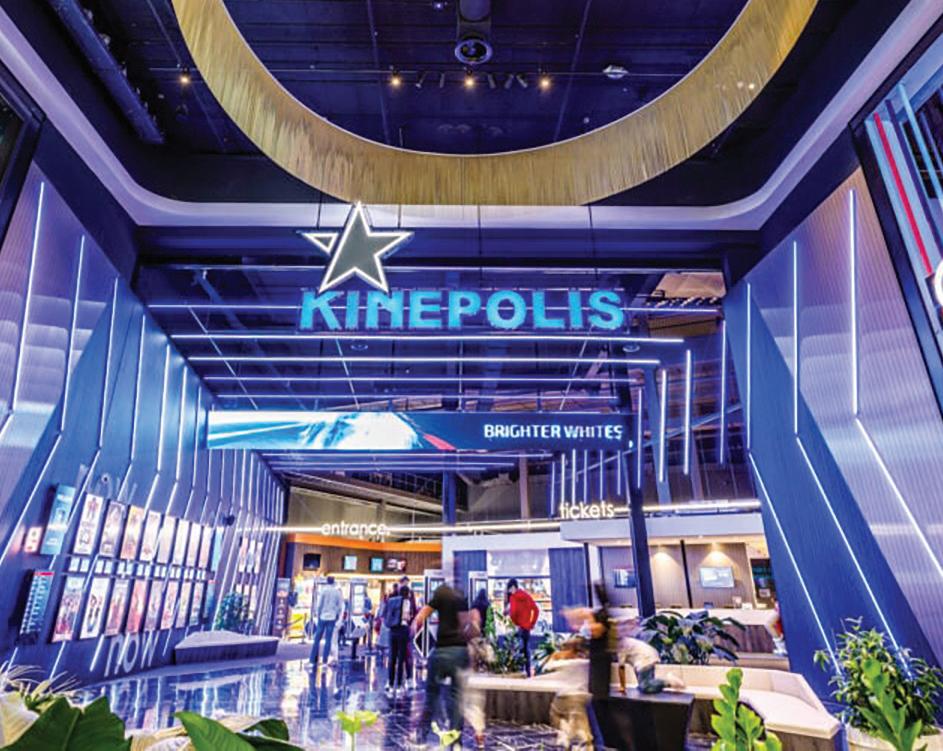
CINEMANEXT NETHERLANDS SELECTED TO INSTALL STATE-OF-THE-ART CINEMA TECHNOLOGY AT THE PULSE OF AMSTERDAM

CinemaNext has been selected to provide comprehensive cinema technology solutions for the highly anticipated Cinema The Pulse, Amsterdam’s newest cultural destination in the vibrant Zuidas district. The innovative nine-screen cinema complex opened its first six screens at the end of June 2025, with the remaining three screens completing the installation when they open later this year.
Located within The Pulse of Amsterdam’s landmark mixed-use development, the 800-seat cinema represents a significant addition to the Netherlands’ exhibition landscape, combining mainstream entertainment with arthouse programming and unique Cinema-On-Demand experiences. The Pulse is a remarkable fusion concept of living, leisure and business, making it a landmark destination in Amsterdam’s architecturally diverse southern district.
“We are tremendously proud to have been chosen as the technology partner for this exceptional project,” said Matthew Jones, Country Manager of CinemaNext Netherlands. “Cinema The Pulse represents everything we value in modern exhibition: cutting-edge technology, operational
excellence, and a commitment to delivering extraordinary experiences for audiences. Our team has worked closely with the Cinebeat team to ensure every technical aspect supports their far-reaching vision for this unique cultural destination.”
The installation features premium Barco Series 4 Smart Laser projectors across all nine screens, for both the six larger auditoriums and three smaller Cinema-onDemand rooms. This sophisticated setup ensures exceptional image quality across the venue’s diverse programming, from Hollywood blockbusters to intimate arthouse screenings. The cinema also utilises CinemaNext TMS, automation and three CinemaNext boothless systems with the audio system provided by Q-SYS. Peter van Vogelpoel, co-founder of Cinebeat and the driving force behind Cinema The Pulse, emphasised the importance of technical excellence in realising their ambitious vision.
“Our partnership with CinemaNext Netherlands has been instrumental in bringing our concept to life. The technology they’ve installed enables us to offer everything from traditional cinema experiences to our innovative Cinema-on-
Demand service, where guests can select films, adjust audio levels, and order refreshments directly from their seats.”
Cinema The Pulse is an initiative by Amsterdam-based film entrepreneurs operating under the Cinebeat banner, including prominent industry figures such as Vogelpoel (Sweetwater Pictures), Marc Smit (Cinéart Film Distribution Benelux), Matthijs van Heijningen, Guurtje Buddenberg (Sigma Pictures), and Julia van de Graaff (LYNX Film). The cinema aims to serve as a cultural and social hub for film enthusiasts, residents, and business users within The Pulse’s dynamic mixed-use environment.
The venue’s technical specification includes high-performance Barco laser projection systems designed to deliver the highest possible image quality for both films and other types of programming. The smaller auditoriums’ Cinema-On-Demand capability represents an innovative approach to personalised cinema experiences, enabled by the flexibility of the installed projection and automation systems. Audiences for these will not only be able to select their films, but also control start times, pause the films and adjust the volume.
The Pulse of Amsterdam, developed by EDGE and VORM, features two towers connected by a plinth housing the cinema alongside dining, retail, and office spaces. The building’s sustainable design and central location in Amsterdam’s Zuidas district position Cinema The Pulse as a significant addition to the Dutch city’s rich cultural infrastructure.
The project represents CinemaNext Netherlands’ continued commitment to supporting innovative exhibition concepts across the Dutch market, combining technical expertise with comprehensive project management to deliver turnkey cinema solutions. It works with both major multiplex chains, as well as individual art-house and independent cinema operations.
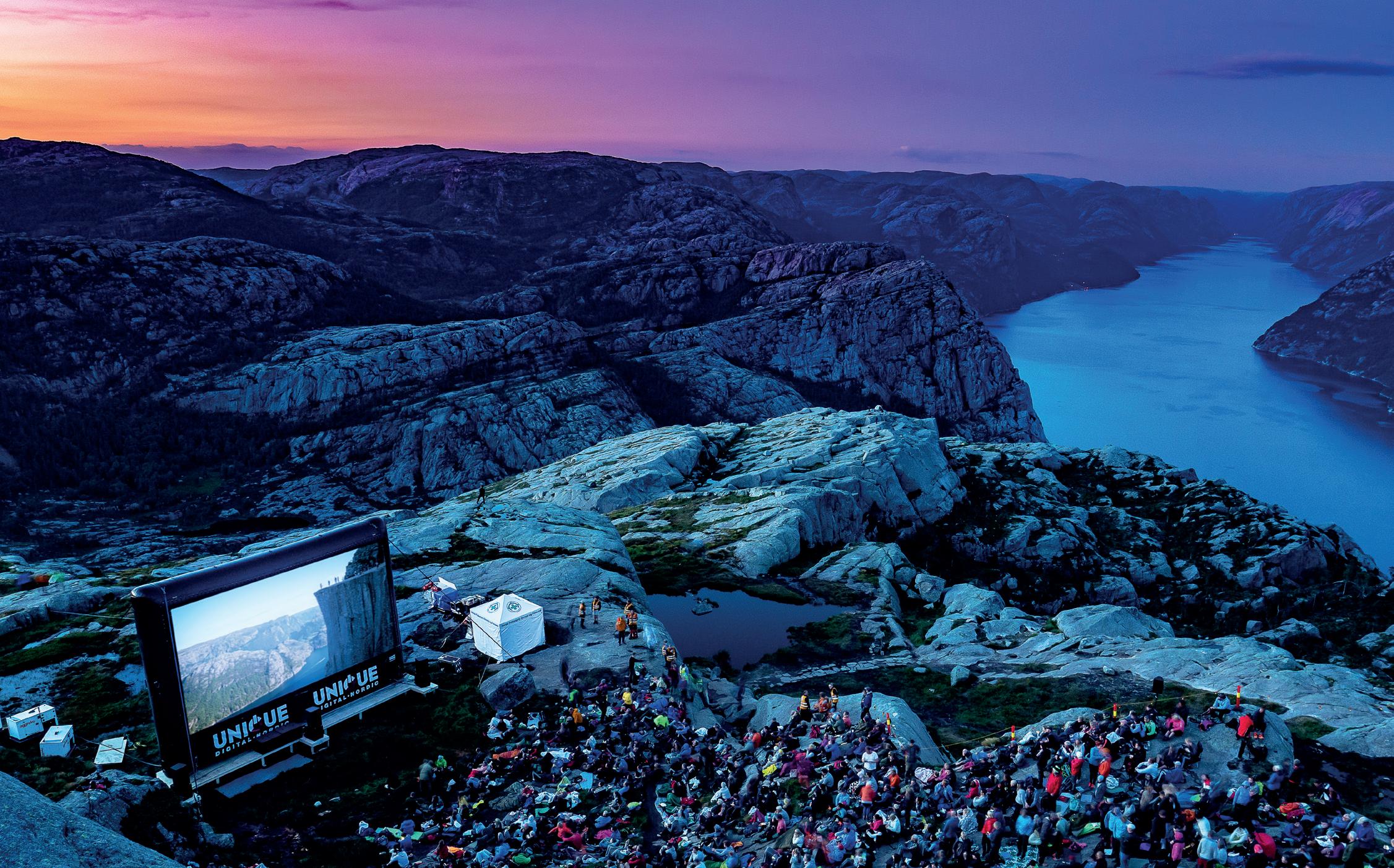
SHOWTIME ANALYTICS RECENTLY ANNOUNCED AN agreement with CineStar, to provide them with a real time operational data and digital marketing platform across their 28 sites.
Blitz-CineStar, founded in 2003, is the leading cinema operator in Croatia and the region, spanning Croatia, Bosnia and Herzegovina, Serbia and Kosovo.
Featuring 182 state-of-the-art halls, including IMAX, 4DX, Screen X and Gold Class, CineStar sets the standard for cutting-edge technology and premium cinema experiences. Recognised for innovation and quality, it has earned numerous awards, including “Best Cinema in Europe” by UNIC in 2019, and continues to deliver exceptional entertainment to over 4.5 million visitors annually.
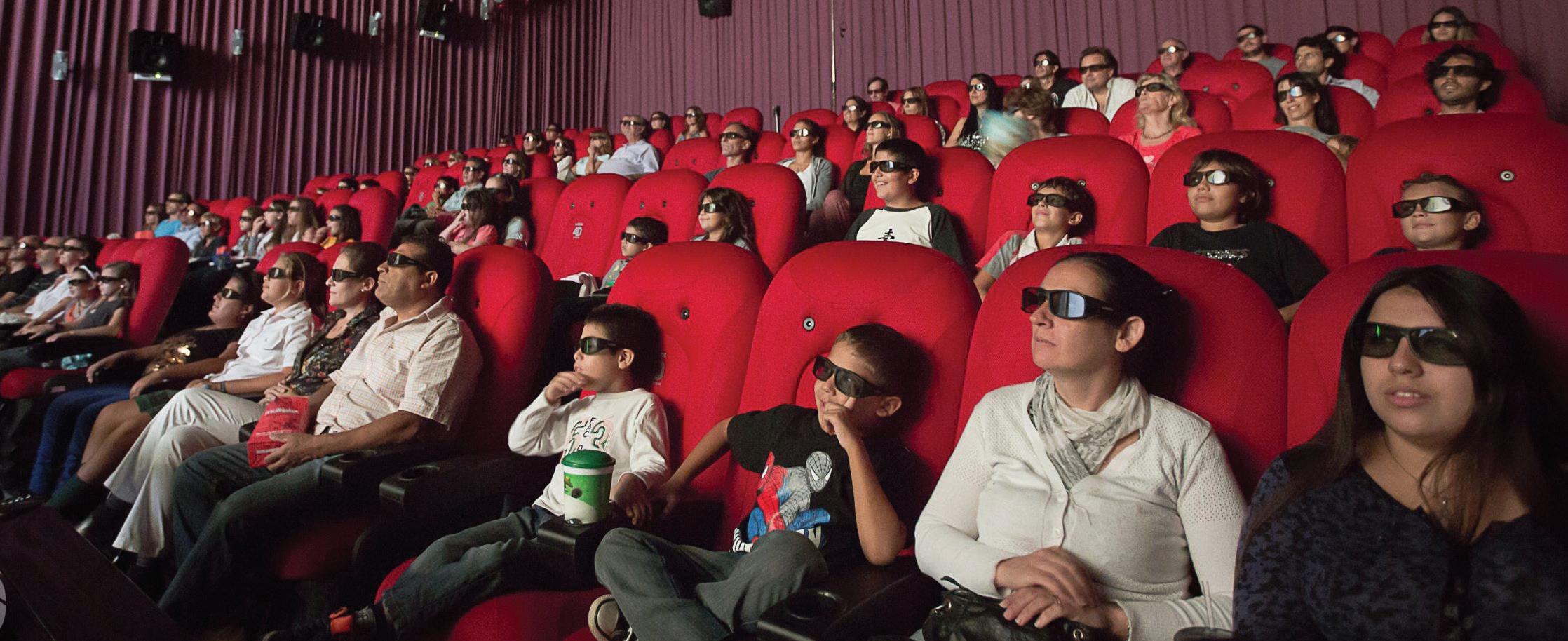
exceptional entertainment to over 4.5 million visitors annually.
With their commitment to delivering an unparalleled theatre experience to their customer base, Blitz-CineStar wanted to use their first-party data to help them understand how their business was performing across the metrics that mattered to them, and use this data to drive customer engagement and loyalty. They reached out to Showtime Analytics to evaluate how their cloud platform could help them do this.
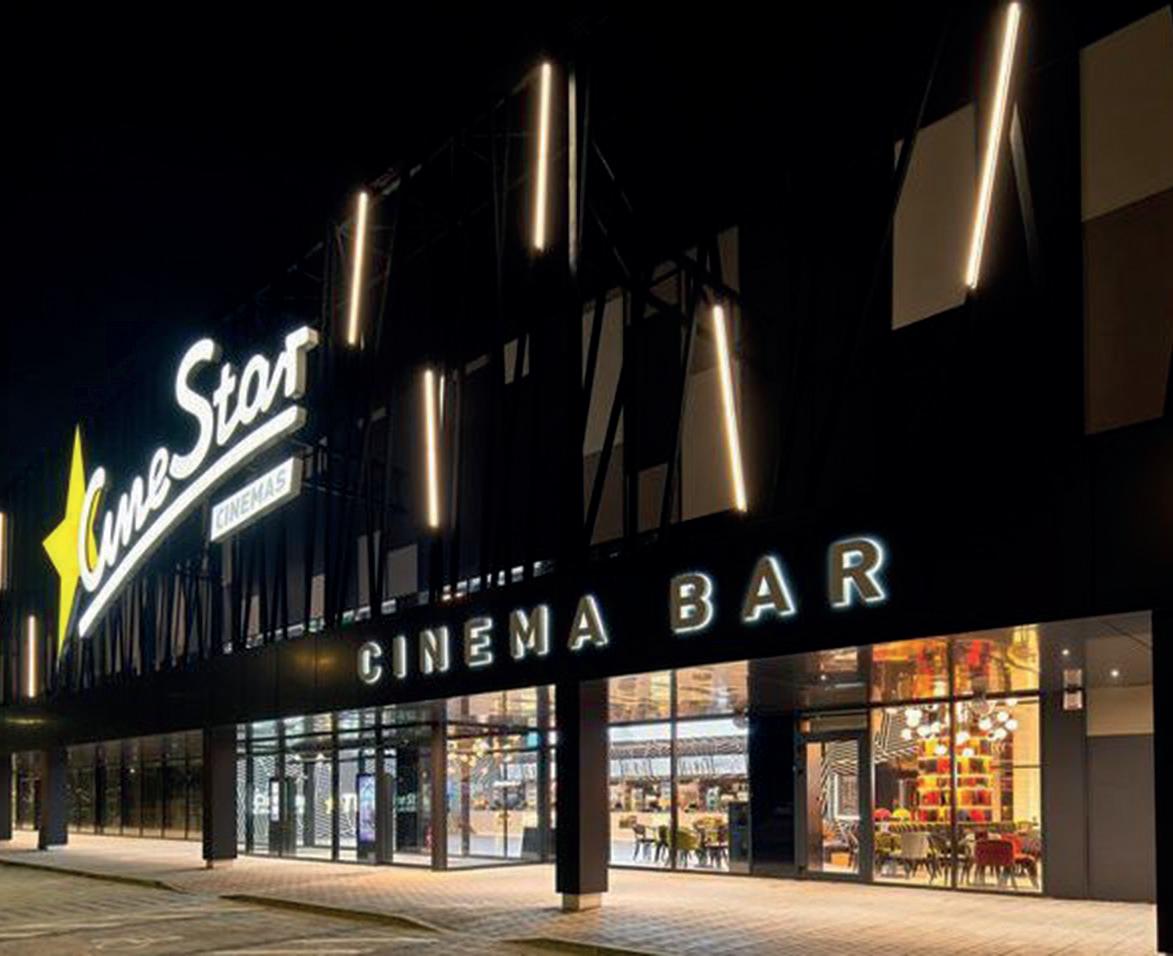

With their commitment to delivering an unparalleled theatre experience to their customer base, Blitz-CineStar wanted to use their first-party data to help them understand how their business was performing across the metrics that mattered to them, and use this data to drive customer engagement and loyalty. They reached out to Showtime Analytics to evaluate how their cloud platform could help them do this.
CJ 4DPLEX (the premium film format and cinema technology provider) and CINEMARK have announced an expansion of their existing relationship with the addition of 20 new ScreenX locations across theaters in the U.S. and Latin America.
Of the 20 new locations, 18 will open across the United States, with six slated to open in 2025 and the remaining set to debut in 2026. As a leading exhibitor in the Latin American market, Cinemark will introduce ScreenX to audiences in the region for the first time, with theaters scheduled to open next year. ScreenX, the world’s first multi-projection cinema technology, surrounds moviegoers with a dynamic 270-degree panoramic field of view. By extending key scenes onto the left and right walls of the auditorium, it creates immersive, story-enhancing visuals that naturally fill the viewer’s peripheral vision and pull them deeper into the film.
By migrating from their existing email marketing tool and integrating their customer data to Showtime Engage, it will allow them to bring individual customer behaviors, touch points and purchase activity together to create a single view of their identifiable movie-goers. Having all this information about their different customers and their shared behaviours, it will give them the ability to create and send targeted, personalised digital campaigns to different segments, driving customer engagement and loyalty. With the closed loop integration with their POS this will allow them to track conversions and revenue uplift from each campaign, putting them in better control of where to focus their marketing efforts.
By migrating from their existing email marketing tool and integrating their customer data to Showtime Engage, it will allow them to bring individual customer behaviors, touch points and purchase activity together to create a single view of their identifiable movie-goers. Having all this information about their different customers and their shared behaviours, it will give them the ability to create and send targeted, personalised digital campaigns to different segments, driving customer engagement and loyalty. With the closed loop integration with their POS this will allow them to track conversions and revenue uplift from each campaign, putting them in better control of where to focus their marketing efforts.
Mrs Jadranka Islamovic, CEO CineStar Cinemas said of the partnership:
“ScreenX is a distinctive premium format that enhances the moviegoing experience by expanding storytelling across our immersive auditorium screens,” said Damian Wardle, Cinemark’s EVP, theater & technology operations. “We are excited to deepen our collaboration with CJ 4DPLEX and bring even more cuttingedge cinematic experiences to our guests, including, for the first time, audiences in Latin America.”
Mrs Jadranka Islamovic, CEO CineStar Cinemas said of the partnership:
“As the best and largest cinema in our region with more than 22 years of operation, CineStar has become a synonym for cinema in our territory. We have a duty to provide each of our visitors with the best value for money through superior service and satisfaction, and to always provide the best and largest selection of films, in technologically superior halls and the most comfortable seats, the always constant quality of CineStar Cinemas. The values on which we base our long-term success are quality, service, trust, innovation and understanding of the needs of our visitors. We hope that with Showtime Analytics, we will now understand our visitors even better, all to improve our relationships with customers, their loyalty and ultimately increase visits.”
“As the best and largest cinema in our region with more than 22 years of operation, CineStar has become a synonym for cinema in our territory. We have a duty to provide each of our visitors with the best value for money through superior service and satisfaction, and to always provide the best and largest selection of films, in technologically superior halls and the most comfortable seats, the always constant quality of CineStar Cinemas. The values on which we base our long-term success are quality, service, trust, innovation and understanding of the needs of our visitors. We hope that with Showtime Analytics, we will now understand our visitors even better, all to improve our relationships with customers, their loyalty and ultimately increase visits.”
Don Savant, CEO of CJ 4DPLEX Americas, stated, “With this deal, Cinemark reinforces their commitment to being one of the most influential theatrical exhibition companies in the world. Together, we’re not just expanding more theaters, we’re revolutionizing how moviegoers watch cinema with our truly differentiated ScreenX format. We’re excited to broaden our footprint in the United States, introduce ScreenX to Cinemark’s Latin American patrons for the first time, and continue pushing the boundaries of the cinematic experience.” CJ 4DPLEX and Cinemark first partnered in 2022 with the launch of their initial ScreenX locations in California and Texas. The success of these theaters, driven by strong audience demand for premium formats, laid the foundation for the expanded agreement.
www.cinema-technology.com


5000:1 contrast without any brightness loss
Extend laser lifetime by more than 50% Up to 85,000 hour laser lifetime

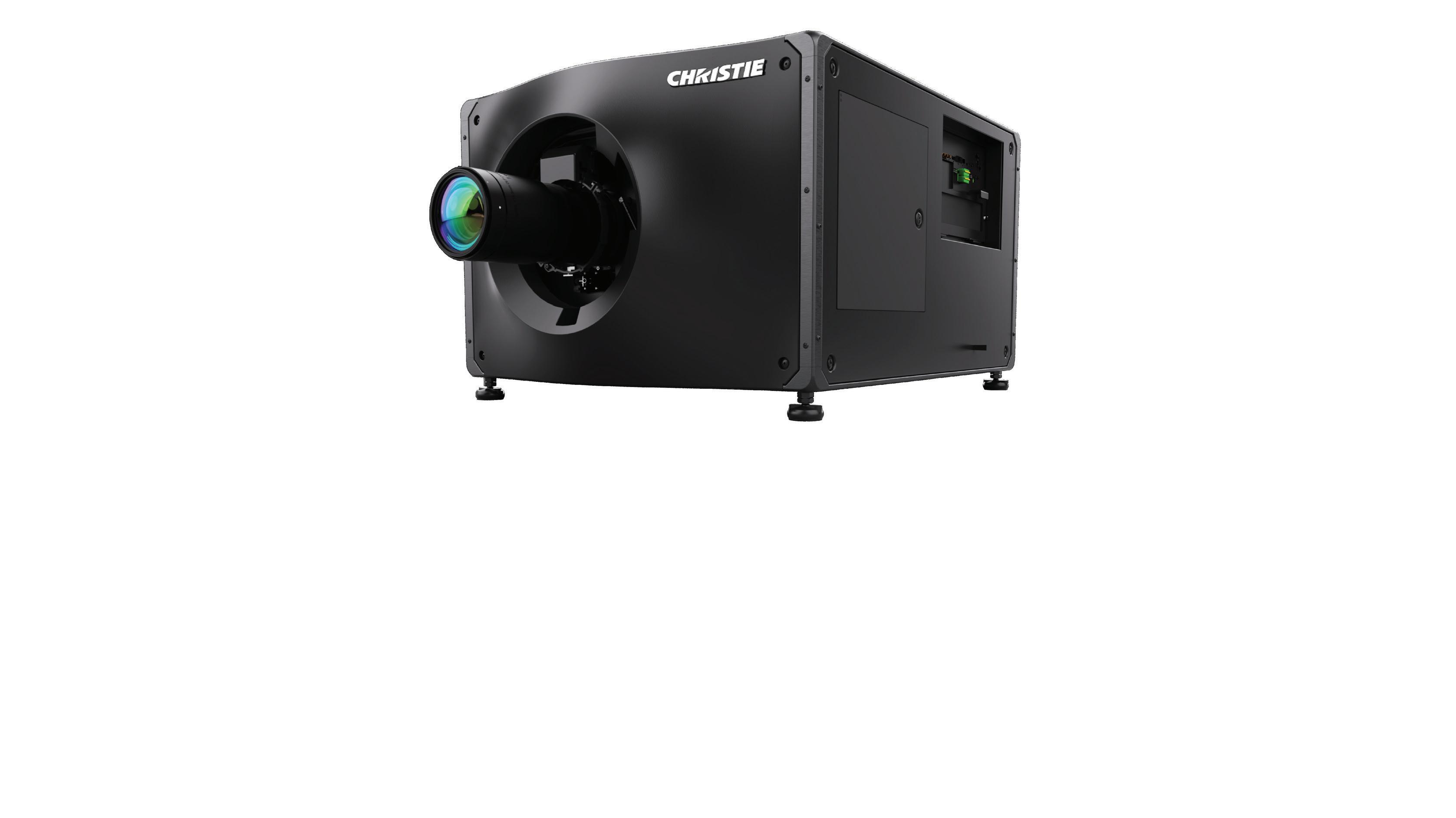
BARCO AND VUE have announced an expansive deal to roll out state-of-the-art HDR by Barco presentation across Europe. The deal will be the cornerstone of Vue’s ground-breaking new premium large format experience, EPIC by Vue.
To create EPIC, Vue is expanding its partnership with Barco to bring HDR by Barco premium cinema presentation to Europe. The agreement will see a minimum of 11 EPIC screens opened in the U.K., Italy, and the Netherlands in 2025, and an additional minimum of 50 EPIC screens opened across Vue’s European estate by the end of 2027. HDR by Barco combines Barco’s industryleading laser projection with its patented ‘Lightsteering’ technology to deliver a premium, high-dynamic range (HDR) presentation for cinema.
The deal with Barco forms a key part of Vue’s soon-to-be-launched premium large format experience, EPIC by Vue. Comprising the latest technological advancements in sight and sound, EPIC features HDR by Barco laser projection, and is part of Vue’s continued commitment to innovation and bringing the highest-quality cinematic experience to the widest possible audience. Each EPIC by Vue screen also features a fully immersive soundscape around and above the audience. An EPIC by Vue auditorium will also always feature the largest screen at that cinema.
EPIC by Vue represents a further development in Vue’s partnership with Barco. In March, the companies announced a deal that will see the installation of more than 1,000 Barco Series 4 laser projectors and Barco media servers across Vue’s screens by the end of 2029. The first EPIC by Vue screen will open to the public at the end of July at Vue’s newly launched site in Nottingham, England.
Commenting on the Barco deal and launch of EPIC by Vue, Vue CEO and Founder Tim Richards CBE said, “After researching and testing a variety of premium large format options, we decided to create EPIC using the very best market-leading technology available. Using cutting-edge HDR laser projection by Barco we will bring the very latest technology to our biggest screens across Europe and give our customers the opportunity to enjoy a cinematic experience like no other.”
“We are delighted to expand our partnership with Vue and bring HDR by Barco to moviegoers across Europe,” said Gerwin Damberg, the executive vice president of Barco Cinema. “Like Vue, Barco is committed to delivering spectacular cinema experiences to all audiences. Together, we are transforming the theatrical landscape with exceptional, cutting-edge movie presentation.”

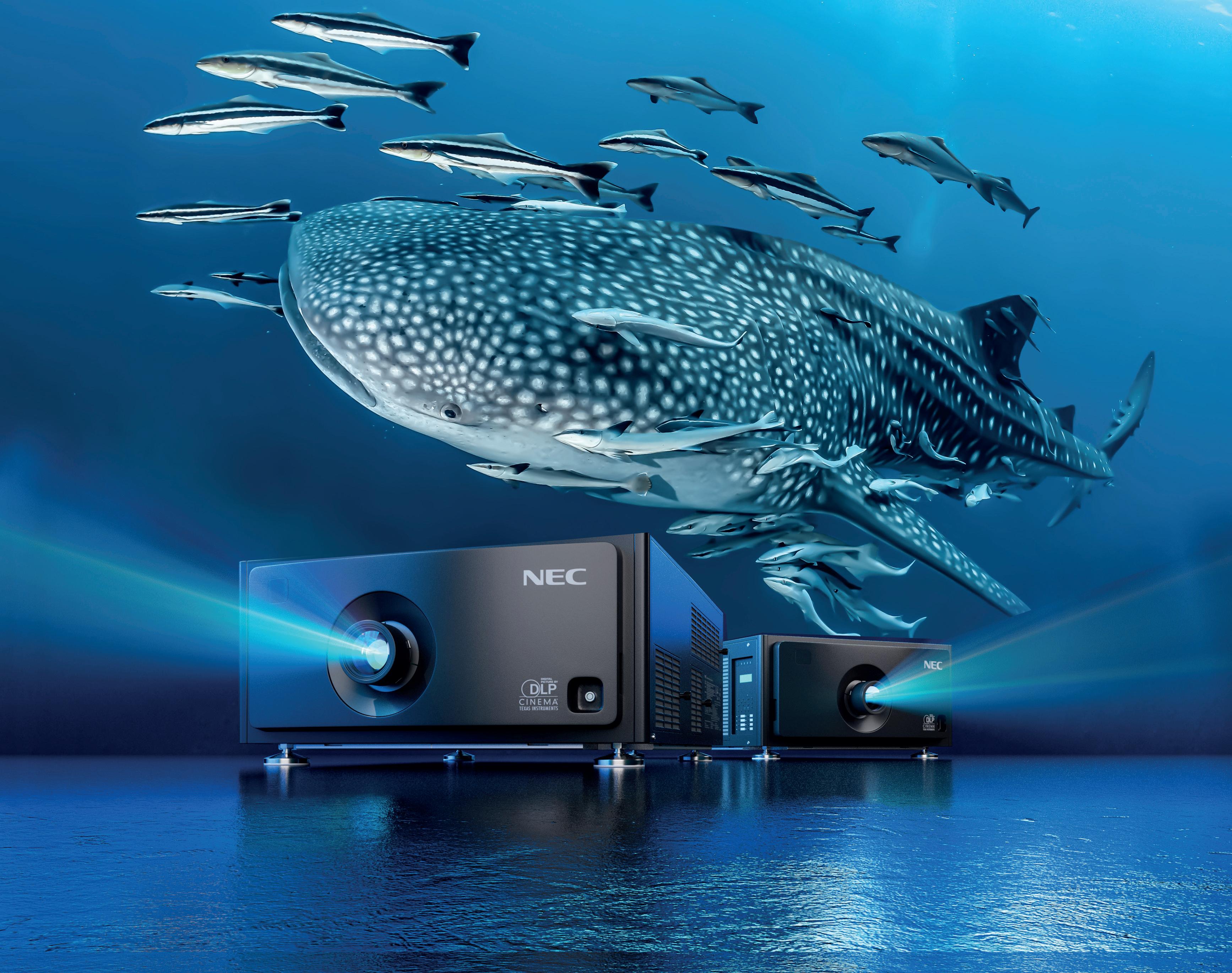
NC603L Laser Cinema, Silent, Sealed, Sustainable
Deliver captivating movie experiences with our NEW ‘Super Silent’ NC603L Laser Projector. Ideal for boothless and Silent Cinema, with an unrivalled noise level below 39dB, 6000 Lumens and a dedication to lifecycle sustainability.
Incorporating the highly efficient latest Laser technology, low power consumption of only 0,89kW, advanced dust protection with sealed engine and laser light source, 50,000 hours Laser life time and lenses interchangeable with the NC1000C family, it’s the perfect choice for longer term performance!
Discover more at sharpnecdisplays.eu Be seen, but not heard
WORDS: TIM POTTER, FOUNDER, TRIGAGE.
As we come to the end of a long summer in Europe, the headlines have been full of heatwaves, wildfires, and droughts. Much of the continent has been crying out for rain, and unless you’ve got an orchard of overzealous fruit trees, chances are your garden looks about as bleached as the hair of Rutger Hauer’s character Roy Batty in the original Blade Runner. Is this warming entirely down to carbon emissions? Maybe. But while the scientists debate, our industry can’t afford to sit back. So we can continue with another Green Shoots this time looking at acoustic panelling, in booth power management, amplifiers and…how green is your tub of popcorn?
Eomac, one of the leaders in acoustic solutions for cinemas, has been championing sustainability in their manufacturing and refurbishment processes.
The acoustic core — the largest component of their projects — is often reused on refurbishments, with only the fabrics replaced. A refresh after 10 or more years of use can completely transform an auditorium without sending serviceable materials to landfill. Their commitment goes further:
› Rockwool, a key material in their designs, is produced from abundant natural rock and comes with a circular, closed-loop recycling system. Offcuts are sent back to their Bridgend factory for recycling.
› Wall carpets are already made from 100% recycled plastic bottles, and acoustic fabrics are now also available as 100% recycled material.
› More sustainable options are emerging too, with
acoustic surfaces now possible in wood veneers, concrete finishes, and other eco-conscious materials.
Eomac’s main manufacturing facility runs on 80% solar energy and uses heat pumps to reduce reliance on fossil fuels. Where wood is required, they source only FSC or PEFC-certified timber from sustainably managed forests. Even the MDF substrates used instead of solid wood are an ecochoice, making use of the entire tree — branches included — and reducing warping over time.
This is all proof that sustainability, style and acoustics can go hand in hand.
While materials are one piece of the puzzle, managing energy use inside the projection booth and rack rooms is another. More cinemas are adopting IP-controllable devices to automate power schedules. But what about older analogue gear, like legacy amplifiers, that don’t integrate so easily?
Solutions are emerging. CinemaNext’s PAA40 offers remote-controlled power management. When integrated with tools from automation software platforms — including the likes of OneCinema’s TMS — it makes it easier to shut down equipment intelligently when it’s not needed.Then there’s the new DM-04-1600 Class D amplifier from KCS: a fully monitored, high-efficiency 1U amp delivering, according to their literature, over 85% energy efficiency. Moving to modern multi-channel amps like these can generate significant savings. KCS provided an example: in a small 7.1 bi-amp configuration, switching from traditional singlechannel amps could save around €2,300 / £2,000
per year. Multiply that across a full circuit, and the numbers start to add up fast.
The short answer: it can be. Compared to processed snacks, popcorn has a low environmental impact, but there are a couple of caveats.
The good news:
› Minimal processing & packaging if bought in bulk
› Naturally plant-based, so lower carbon footprint than animal-based snacks
Generally low water use compared to other crops
The bad news:
› Conventional maize farming can involve heavy pesticide use
› Cinema popcorn typically comes in single-use tubs albeit we are seeing a higher percentage of recyclable and reusable tubs now which is excellent. Greener choices? Use organic bulk kernels, air pop where possible, and opt for reusable containers. Small changes add up when you multiply them across thousands of screenings.
This summer has been a reminder of the pressures our planet faces. But as these examples show, cinemas can play a role in shaping a lower-carbon future, whether it’s smarter materials, energy-saving workflows, or even rethinking what’s in the snack bar. We’ve got work to do, but there’s plenty of innovation out there. Until next time, keep the proverbial reels turning — sustainably, of course.

Globally, the early summer period of May to July delivered strongly versus last year. Seven of the Top 10 films of 2025 were released in the quarter, led by May’s Lilo & Stitch joining the billion-dollar club. Summer momentum slowed somewhat in August as we moved into traditionally the quietest point of the year, although renewed interest in the horror genre bodes well for autumn prospects.
WORDS: LUCY JONES, EXECUTIVE DIRECTOR,
COMSCORE MOVIES.
Latest figures from Gower Street Analytics show that, after eight months, the total Global box office is estimated to have reached $22.9 billion in 2025. This is 5% above the same period last year, and 8% below the equivalent period of 2023 (which was boosted by that year’s #Barbenheimer summer).
We remain on track to top $34 billion by the end of the year, ahead of both 2023 and 2024 for the biggest post-pandemic finish.
Success was more concentrated than in 2024, with 41% of revenues going to the Top 10 films. The equivalent figure for the first eight months of 2024 was 38%, and in 2023 it was a healthier 36%. This chimes with the widespread feeling that cinemagoers are becoming more selective about which films to watch theatrically, wanting to be part of the moment around the buzziest films and flocking to long-beloved franchises. Encouragingly, the two most highlyrecommended titles from our UK PostTrak poll were originals – F1 The Movie and Sinners, whose positive word of mouth resulted in strong multiples and proved that as with Barbie and Oppenheimer, original stories can generate as much buzz as franchises.
Four 2025 releases have already entered the all-time worldwide Top 100 films chart: Ne Zha 2, Lilo & Stitch, A Minecraft Movie and Jurassic World Rebirth. This is on a par with full-year 2024, when Inside Out 2, Deadpool & Wolverine, Moana 2 and Despicable Me 4 ranked inside the all-time Top 100. By the close of 2025, it looks likely that this year will achieve even more entries into the Top 100, with candidates including November releases Wicked: For Good and Zootopia 2 followed by Avatar: Fire And Ash in December.
WORLDWIDE TOP RELEASES OF 2025:
WORLDWIDE CUMULATIVE GROSS IN $ NUMBER OF TERRITORIES % OF GROSS OUTSIDE
HOW TO TRAIN YOUR DRAGON
F1 THE MOVIE SUPERMAN
MISSION IMPOSSIBLETHE FINAL RECKONING
THE FANTASTIC FOUR: FIRST STEPS
DETECTIVE CHINA TOWN 1900
Focusing on Europe, UK & Ireland remains the strongest territory after eight months, running 9% ahead of 2024 at the same point despite releasing fewer films this year.
As well as the US studio productions that feature in the Global Top 10, British favourite Bridget Jones: Mad About The Boy has remained near the top of the UK chart since its February release, contributing £46.3m as the secondbiggest entry in the franchise. Eight titles attracted a particularly large proportion of infrequent cinemagoers, with at least half of attendees coming every two months or less often: parents for family titles A Minecraft Movie, Elio and Grand Prix Of Europe; older women drawn to Bridget Jones: Mad About The Boy and The Last Showgirl; younger women for One Of Them Days; and older friends and couples for The Alto Knights and Marching Powder.
Germany is also ahead of 2024, receiving a huge boost from the mid-August release of local comedy sequel Das Kanu des Manitu – already one of the top films of 2025 and on track to overtake current leader A Minecraft Movie. Spain was ahead until the final two weeks of August, while Italy remains on par with 2024. Dropping behind is France, 15% adrift of last year which was itself down on 2023.
Despite a strong start to 2025, the deficit has been widening since April; normally driven by local productions, only three French films feature in the year’s Top 20, and none of the local titles released since April has achieved 1 million admissions. February’s God Save The Tuche looks set to remain the top French film of the year, while comedy sequel Chasse Gardée 2 should rank second when it releases in December.
TOP 5 WESTERN EUROPEAN TERRITORIES – JANUARY TO AUGUST 2025:
Across all European cinemas combined, four of the Top 20 films this summer were European productions or co-productions, just one less than last year which was impacted by the US strikes, and significantly up from the single European production that appeared in Summer 2023’s Top 20. However in contrast to prior years, it isn’t French films in the driving seat.
Summer 2024 saw French films dominate the chart with half of the Top 20 European productions coming solely or jointly from France, led by comedy smash Un P’tit Truc en Plus (A Little
Something Extra) taking almost €80 million across Europe and achieving over 11 million admissions within France. 2025 has followed a different path, with the UK producing/coproducing eight of the Top 20 titles, ahead of France’s five and Germany’s three titles. Top UK entry is well-received horror sequel 28 Years Later, contributing almost €40m at the European box office. The film had broad appeal across age and gender, with almost half of its UK audience aged under 25 despite the 18-year gap between this release and the prior instalment.
TOP EUROPEAN FILMS AT THE EUROPE BOX OFFICE
– MAY TO AUGUST 2025:
Horror films are flourishing this year, with a mix of sequels and original stories adding $1.83 billion to the global box office by the end of August. Warner Bros. is seeing particular success, releasing all three of the top titles: Sinners, Final Destination Bloodlines and Weapons. 28 Years Later and Nosferatu complete the horror Top 5, with Nosferatu taking the top spot within Europe. All of these titles played in premium formats such as motion experience or IMAX, resulting in a compelling combination of factors attracting audiences: a bigger experience than home viewing, strong word of mouth and social buzz driving FOMO, and the shared experience of scares and laughs in a dark auditorium.
Like comedy, horror is a genre that thrives in the communal environment of the cinema, elevating an individual’s enjoyment through the shared experience. With spooky season upcoming and many viewers exposed to trailers during their summer visits, we can expect success to follow for the next batch of releases including The Conjuring: Last Rites, Five Nights at Freddy's 2 and The Black Phone 2. This will be welcome business for cinema operators as they anticipate the year’s grand finale – box office powerhouses Wicked and Avatar.
MAS QUE UNO 5
LA VENUE DE L'AVENIR
PEPPA MEETS THE BABY CINEMA EXPERIENCE
THE PENGUIN LESSONS
TERNET NINJA 3
DRACULA
PARTIR UN JOUR
GRAND PRIX OF EUROPE
Y A PAS DE RÉSEAU
SIHIRLI ANNEM: HEPIMIZ BIRIZ
13 JOURS 13 NUITS
THE BALLAD OF WALLIS ISLAND
CONCLAVE
OCEAN WITH

CineEurope 2025 brought the industry together in Barcelona for four days of screenings, seminars, technology showcases and networking. From HDR projection and LED breakthroughs, to retail innovation and people strategy, the event highlighted the many fronts on which cinema is evolving. Here’s a reflective look back at the highlights and what they mean for exhibitors and technologists.
When the cinema industry descends on Barcelona each June for CineEurope, the CCIB fills with a unique blend of optimism, pragmatism and curiosity. By the time you are reading this, the event will be several months behind us, but perhaps that is the best way to look back: not in the immediate afterglow, but with perspective. CineEurope is more than just one thing. For some, it is the studio slates. For
others, it is the technology showcases. For many, it is the seminars or the chance to meet peers face to face. The real strength of the event lies in the fact that all these elements are equally valuable, and that it is the combination, rather than any single aspect, that defines CineEurope’s role in the industry calendar. This year’s edition reflected both continuity and change. Continuity in the sense that the core pillars of studio presentations, trade fair, seminars and awards remain in place and change in the sense that the industry itself is evolving rapidly; and CineEurope is where those shifts were most clearly on display.
The studios once again used CineEurope as their European stage. Disney, Warner Bros., Universal, Paramount, Sony, Lionsgate and STUDIOCANAL each took to the enhanced CCIB auditorium, supported by the familiar technical partners Barco, Dolby, Harkness, RealD and QSC. Their presentations reassured audiences that despite the ups and downs of the past couple of years, there is plenty of content in the pipeline to keep the industry moving into 2026 and beyond.
UNIC’s leadership, fronted by Laura Houlgatte, set the broader industry context in the opening address. The headline figure for 2024 was stability: €7.2 billion in box office across EMEA with 975 million admissions. That stability was not achieved without difficulty. The Hollywood strikes left gaps in release schedules, and some markets, notably France and Germany, remained sluggish. Other countries,
including Italy, Romania, Hungary, Slovakia and Estonia, recorded growth, showing that audiences were still willing to come when content was available. By April 2025, the tide was beginning to turn, with A Minecraft Movie and Sinners providing a shot in the arm with Europe accounting for more than half of global box office that month. The key message from the studios and from UNIC was that resilience is real, but it depends on content. Theatrical thrives when it offers a full spectrum of tentpoles to local productions, event cinema and arthouse. CineEurope’s programme reflected that reality, reminding delegates that while technology and retail may be evolving, it is stories that keep people buying tickets.
The conference sessions provided a mirror to the industry’s current preoccupations.
A packed panel titled "From Scroll to Screen: Turning Social Buzz into Box Office Sales" tackled the elusive link between online chatter and ticket sales. Marketing teams from exhibitors and distributors discussed how they are beginning to treat TikTok and Instagram as conversion tools, not just awareness builders. Campaigns that harness influencers, capitalise on memes and track engagement in real time are becoming part of the serious marketing arsenal. The message was clear: social media is no longer a side channel, it is an integral part of the sales funnel. Artificial intelligence was given its own dedicated spotlight in "AI & Cinemas", which brought both excitement and caution in equal measure.

Panellists spoke about the opportunities for smarter scheduling, predictive analytics and personalised marketing, but also raised concerns about intellectual property, algorithmic bias and the skills gap in adapting staff to new tools. The takeaway was pragmatic rather than alarmist: AI will not replace cinema workers, but those who know how to use it will certainly have an edge. The people side of the business was front and centre in the UNIC People Programme, under the theme "The War for Talent – How to Attract the Best in the Industry". Recruitment and retention remain persistent challenges for cinema operators competing with other leisure and retail sectors. Ideas ranged from creating clearer career pathways to offering more flexible working conditions and investing in training. What emerged was an acknowledgement that the future of exhibition depends not just on technology and content, but on the people delivering the experience day to day.
Retail and concessions once again took a prime slot thanks to Coca-Cola. Their seminar "Unattended. Unstoppable." made a strong case for frictionless retail, from self-checkouts to smart vending, as part of the future customer journey. The companion session, "Reinvent Yourself. Repeat.", was equally pointed, drawing lessons from other disrupted industries like petrol stations to argue that cinemas must continually reimagine themselves rather than rely on tradition.
"A Spotlight on Sweden" rounded out the programme, offering a reminder that national contexts
matter. Sweden’s strong base of local production, combined with state support and diverse audience demographics, provided an example of how different market structures can influence success. Other sessions addressed piracy, diversity and European policy, underlining the fact that CineEurope is as much about strategy and advocacy as it is about technology.
For CT readers, CineEurope’s technology demonstrations are always at the heart of the show, and this year’s programme did not disappoint.
Christie’s Variable Dynamic Range (VDR) demonstration stood out for its elegant simplicity. By toggling the system on and off, delegates could immediately see the difference: deeper blacks, richer detail and a picture that simply had more life to it. The key point is that VDR is a software-based feature for CineLife+ Series Real|Laser projectors, enabled without special mastering. Alongside VDR, Christie highlighted its CineLife+ IMB platform for high-framerate 4K playback and expanded storage, reinforcing a message of efficiency as much as impact.
Barco continued to build momentum behind HDR by Barco, developed with Colorfront. The sideby-side HDR versus SDR demonstration made the added depth and contrast unmistakable, and the accompanying workflow session focused on keeping creative intent consistent while streamlining mastering and exhibition. The subsequent Vue agreement to roll
out HDR by Barco screens across Europe underscored its PLF ambitions.
Samsung also had a milestone moment with the first European showing of its Onyx Cinema LED ICD model. Offering 4K resolution, HDR at up to 120 Hz and peak brightness of 300 nits, the system combines technical punch with the reassurance of a ten-year warranty. The demo impressed not only for its visuals but for its sound. Long criticised for acoustic challenges, LED cinema now seems to have found answers, with dialogue and bass response that felt natural and cinematic. Samsung’s work with Pixar on HDR mastering for Elio further signalled that major content creators are taking LED workflows seriously.
Beyond these headline demos, GDC and Timewaying showed a perforated, sound-transmissive LED approach under the Cine LeDMAX and HeyLED

banners, allowing main speakers to remain in their familiar positions behind the display. HeyLED’s 3D demo was visually striking, producing bright, crisp images with far less of the usual light loss. For glasseswearers, the eyewear remains an issue, but the overall quality demonstrated that 3D still has a place when delivered well.
While the big demos captured attention, the trade floor rewarded those who wandered further.
CinemaNext introduced its PAA40+ automation adapter, a compact but powerful tool for managing booth energy use. By enabling remote switching, scheduled power cycles and real-time monitoring of up to a dozen circuits, it offers operators a way to trim energy costs, a pressing concern across Europe. It was a reminder that sometimes the most impactful innovations are not those that dazzle audiences, but those that make the business more sustainable.
Sustainability was also the theme on the stand of PCO Group GmbH, who brought along reusable popcorn buckets, branded cups and the playfully named “shush flutes.” Simple though they might seem, these items highlighted the direction of travel for concessions: less waste, more customer engagement and the chance to keep branding alive long after the credits roll. For those thinking bigger, Build Tech Group offered a full-service construction model, promising to take cinema projects from the first sketch through to the final seat. At a time when refurbishment and new builds can feel dauntingly complex, the pitch for a single point of delivery was compelling.
Even popcorn had its moment of theatre. Maison Popcorn’s “Popcorn Museum” brought a touch of nostalgia to the floor, reminding delegates that cinema is not only about technology but about rituals, smells and memories. On the technical side, Harkness Screens unveiled its HSG Labs Checker, a modernised handheld successor to the Digital Screen Checker. It is calibrated for all projection types including RGB laser and measures 0 to 40 fL with around ±1 fL tolerance, plus SPL readout and a 10-band spectrum analyser, so staff can keep tabs on presentation quality between full calibrations. Finally, Cinemeccanica presented IMAGO, a camera and sensor-based system that monitors projection and

The traditional awards evening closed the convention, but rather than simply listing trophies, it is worth reflecting on what these honours signify.
Kinopolis was recognised with the Milestone Award, a testament to decades of sustained contribution to European exhibition. The UNIC Achievement Award went to Tomasz Jagiełło of Helios Poland, highlighting his leadership in modernising cinemas across Central Europe. Pathé received International Exhibitor of the Year, while Angel Studios and Leonine Studios were noted among distributors. Disney, meanwhile, was recognised for the European success of Moana 2.
These awards may make headlines elsewhere, but for CT readers the interest lies in what they represent: a reminder that innovation and leadership come in many forms, whether it is running a successful family circuit, steering a national chain or delivering content that audiences embrace.
audio quality automatically. The easy-to-install sensors and software check brightness, colour accuracy and presence of sound on each channel, giving multiplex teams a way to spot issues before audiences notice them very much in the same way the HSG Labs products from Harkness do.
CineEurope 2025 demonstrated an industry in motion on multiple fronts. The big technology stories, Christie’s VDR, Barco’s HDR and Samsung’s LED, were accompanied by quieter but equally important developments in energy management, concessions, construction and quality control. The sessions tackled the pressing issues of audience engagement, AI, staffing and retail. And the awards recognised the individuals and companies driving the industry forward. Perhaps the most important message was that cinema’s future is not reliant on one big breakthrough. Instead, progress is happening in small increments and bold leaps alike, in projection booths, in lobbies, in boardrooms and on social media feeds. CineEurope remains the place where these strands come together, reminding us of where we have been, showing us where we are heading and giving us the chance to talk about it face to face.
As we move into 2026, that balance of reflection and foresight will be more valuable than ever.
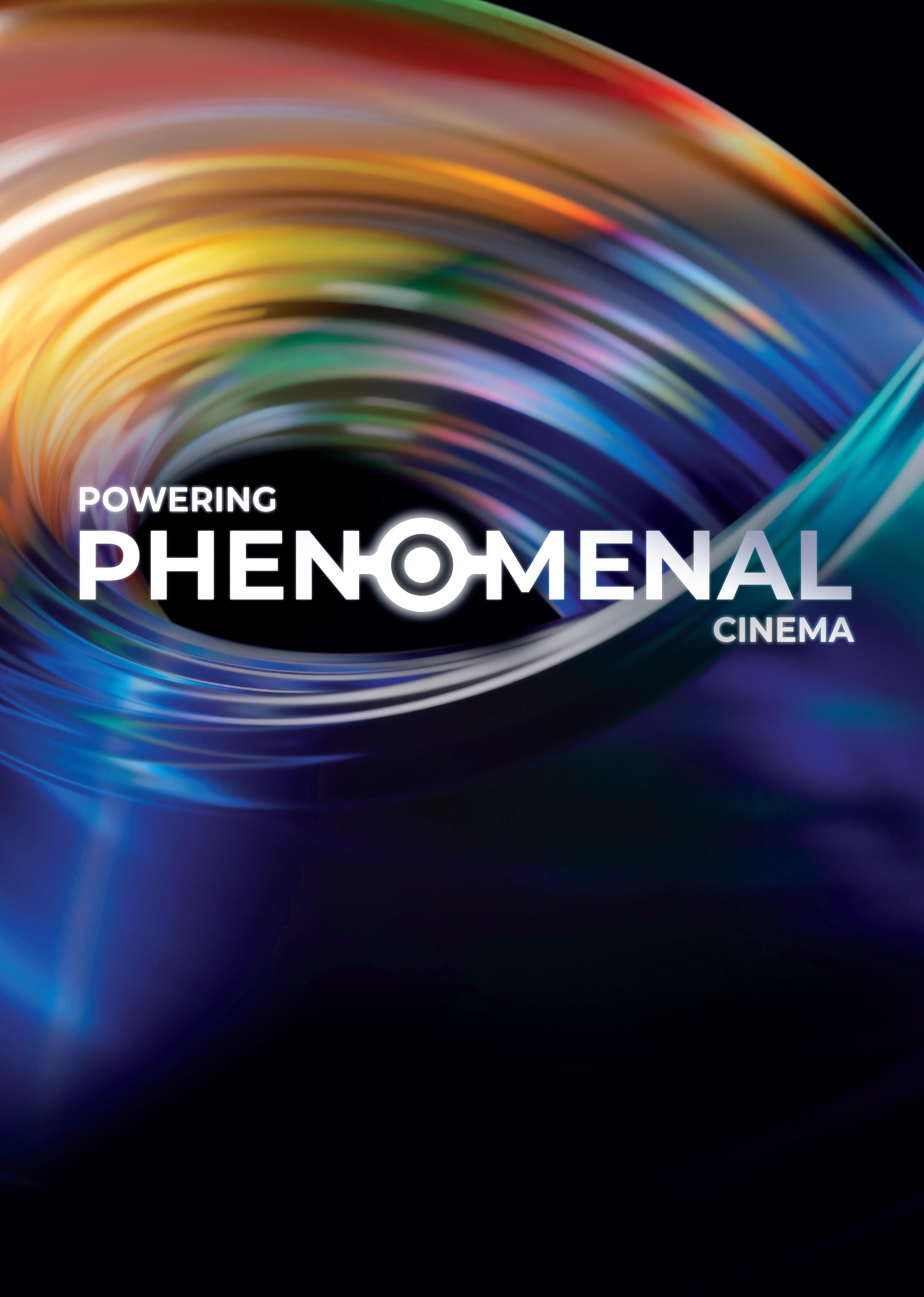
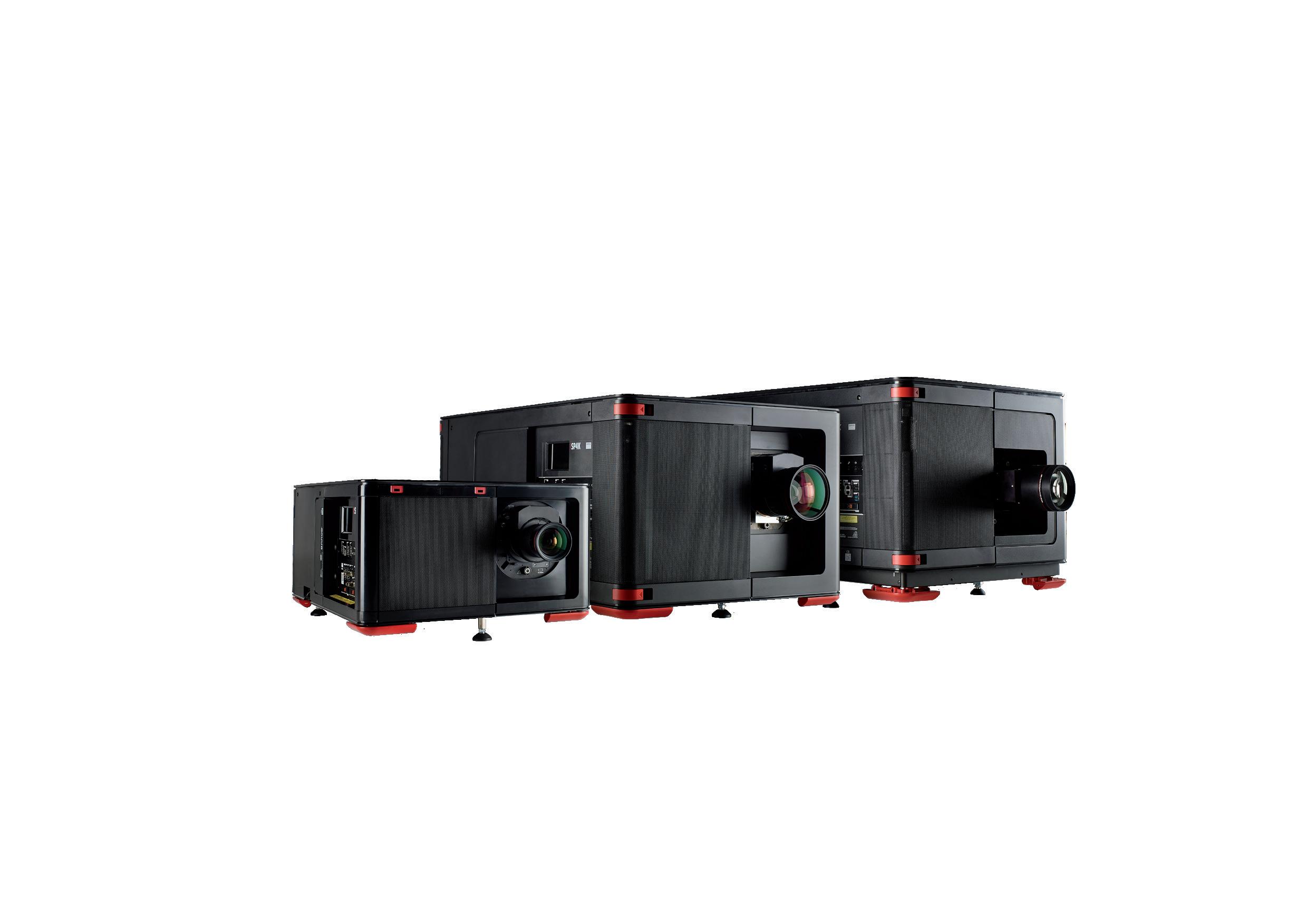
WORDS: ARACELI VAELLO, VICE PRESIDENT OF SOLUTIONS, CINEMANEXT.
The cinema industry is once more at a turning point. While great films continue to draw audiences back to cinemas, the operational model behind the scenes is under increasing pressure. Rising energy costs, environmental regulations, and reduced technical staffing have created a perfect storm – one where energy management and automation are no longer optional, but essential for survival and growth.
Cinemas are energy-intensive environments. Every projection system, loudspeaker array, lobby display, HVAC unit, lighting setup and even
popcorn warmer draws power, and often runs for hours unnecessarily due to manual oversight, staffing gaps or limited scheduling tools. At the same time, many exhibitors are having to do more with fewer resources than ever before. On-site technicians are rare. Engineers and IT managers often oversee dozens of sites, leaving little room for reactive maintenance, let alone proactive energy management. The result? Power is wasted. Equipment wears down faster. Costs mount silently. And when problems occur - whether it’s a sound rack left running overnight or an air conditioning unit drawing excessive load - it’s often too late to remedy.
These operational challenges are not confined to a particular segment of the market. Smaller cinema chains often lack the staff needed to manually control systems, leaving screens powered longer than necessary, while mid-sized chains typically rely on local operators, where human error (forgotten shutdowns, incorrect configurations, or missed alerts) can easily disrupt performance and inflate costs. Larger exhibitors, while often better resourced, face energy bills at a scale where even small inefficiencies can result in significant financial losses across dozens or hundreds of screens.
The PAA40+ Automation Adapter was thus engineered with direct input from cinema operators, integrators, and facility managers. Its feature set reflects the exact pain points the industry is experiencing today:
› Remote and scheduled power cycling - It allows exhibitors to power down projection and any equipment during idle hours or sync with the server or TMS show schedules for seamless automation.
› Monitoring of up to 12 power circuits (up to 16A each) - Gain precise visibility into energy draw per room, system or device.
› Integrated DALI lighting control - Centralise
lighting automation alongside AV systems, including scene recall and labelling.
› Daily, weekly, and monthly energy reports
- Track trends, compare performance, and feed data into ESG or cost control reports.
› 20 customizable macros - Execute chained actions (up to 12 commands each) for showtime preparation, shutdown sequences, or emergency modes.
› Log storage + Real-Time Clock (RTC)Maintain full traceability of actions, power events, and anomalies,even during network outages.
› Mobile-friendly WebUI + Local LCD display -- Check status, configure settings, or
troubleshoot from anywhere. No software install required.
› 100 Mbps Ethernet + Multicast supportReady for integration into complex, networked cinema environments.
› Wi-Fi & Access Point mode - Simplify setup and ensure fallback access when connectivity issues arise.
› Firmware upgradeable via WebUIStay current with the latest features and security patches without hardware swaps.
› Compatibility with PAA20+ and Jnior setups - Allowing easy integration into existing infrastructure.
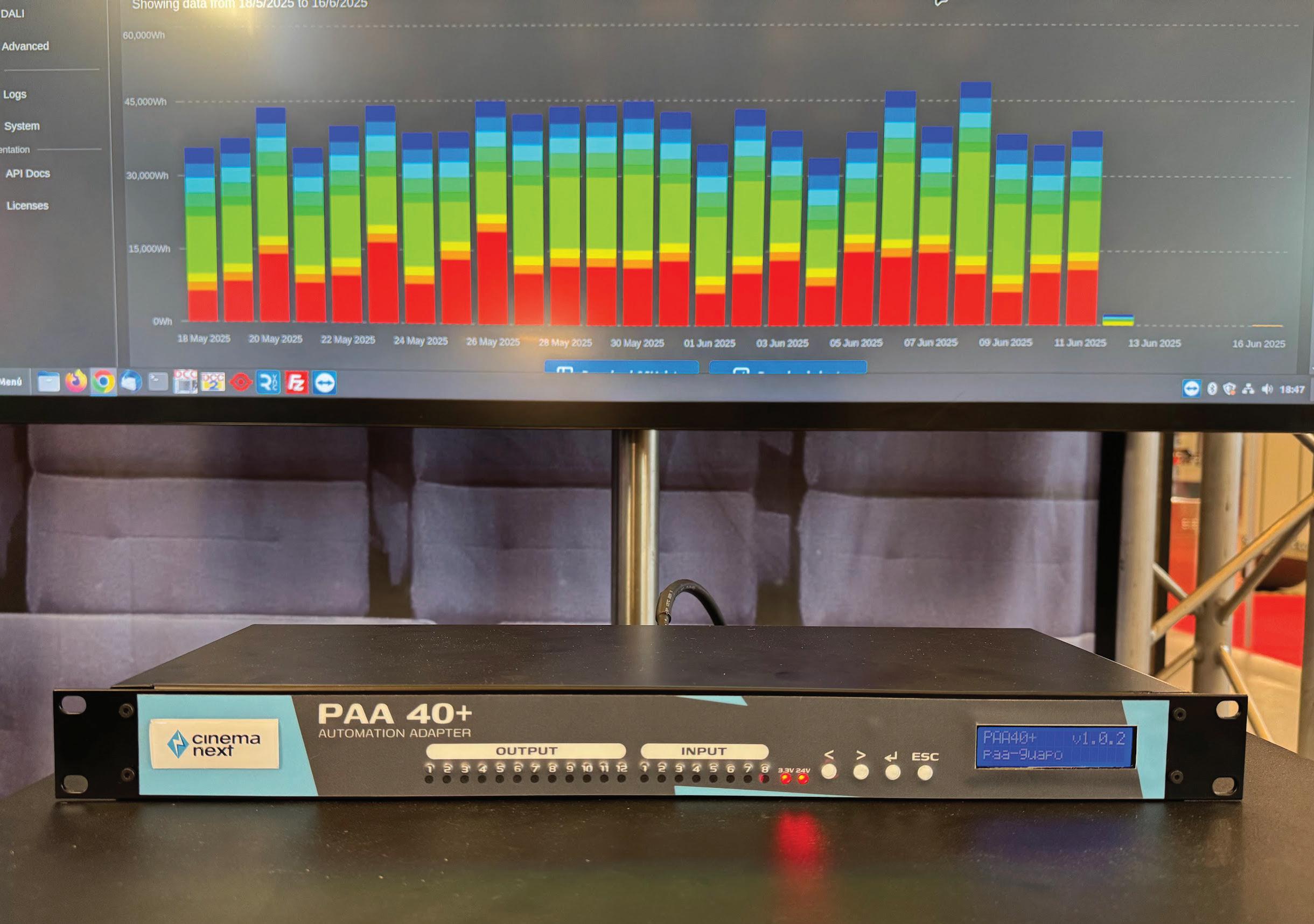
All share a common need: a solution that combines intelligence, automation, and visibility in one cohesive platform.
With CinemaNext covering multiple territories, we encountered these issues constantly in dealing with our customers. Whilst we dealt with these problems reactively, our Spanish office, where our Solutions division is based, decided to tackle this pro-actively. This is where first the PAA20+ and now the PAA40+ Automation Adapter comes into play as more than just a monitoring tool.
The PAA40+ Automation Adapter was designed to combine real-time energy analytics with intelligent automation, empowering exhibitors of any size to move from reactive troubleshooting to proactive, efficient operations, thus cutting waste, extending equipment life, and enabling better decisions through data.
The need was real and rather than hiring more service engineers, designing a solution that put cinemas themselves in charge of their energy usage was the way forward.
Based on early test installations and POC deployments, initial data from PAA40+ deployments show real, tangible benefits: energy cost reductions of up to 38% in operational multiplex environments, greater operational consistency through automated energy management, and smoother showtime transitions with fewer human errors.
Whilst we have seen savings vary by site and configuration, the return on investment is typically achieved in under three years (often a lot quicker), after which time every kilowatt-hour saved translates directly into real money in the exhibitor’s pocket. In a landscape where operational margins are tightening, this kind of sustained cost reduction makes a measurable difference.
But the benefits go beyond cost. The value of automation is immediate. Operators make fewer mistakes. Fewer manual interventions are required. And technical teams can focus on what really matters, rather than routine power checks and manual system resets. When we
demonstrated the PAA40+ at CineEurope this year, this function jumped out as the one that the cinema operators we demonstrated it to said would make a big operational difference, on top of the energy savings.
In an era when cinema exhibitors need to operate leaner, greener, and smarter, tools like the PAA40+ aren’t just useful, they’re transformative and arguably essentials. They allow exhibitors to regain control over their infrastructure, make data-driven decisions, and align with the demands of modern audiences and regulators alike.
As we move into a future shaped by automation and sustainability, the real opportunity for cinemas isn’t just at the box office. It’s behind the screen, where smart technology is quietly redefining how we run the show. It may just be a box, but for those that have seen it in action, it comes across as real-life magic.
Harkness Launches the HSG Labs Checker Experience

For as long as modern cinema has relied on digital projection, one of the simplest and most effective tools for ensuring presentation quality has been Harkness' Screen Checker. From the very first model through to the second-generation version, which is still in daily use across cinemas worldwide, the Screen Checker has offered engineers and technical managers an accessible way to verify the most fundamental part of the cinema experience: light on the screen.
The importance of that may sound obvious, but anyone who has spent time in projection knows how often presentation can drift. Lamps lose intensity, filters age, and projectors slip out of calibration. A well-used Screen Checker has become the first line of defence, giving engineers an instant reference point without the need to set up their full suite of professional test instruments.
Over the years, countless cinema operators have carried one in their bag, ready to confirm that a screen is hitting specification or to back up a hunch when something hasn't felt quite right. In many ways it became the unofficial badge of the field engineer, the small piece of kit that was always on hand when walking into an unfamiliar projection room.
As Richard Mitchell, (Harkness), reflected to CTM back in 2012 when the 1,000th Digital Screen Checker had been sold, “The groundswell of interest behind the product has been phenomenal; there’s been a real buzz about it which appears to be continuing as the industry gets more switched on to issues surrounding on-screen brightness levels.” He went on to describe the Checker as “well on the way to becoming the tool of choice for use when checking screen brightness in auditoria and a low-cost, zerocompromise solution where the more expensive meters are unaffordable.” Those words capture why the device quickly embedded itself into everyday cinema practice with more than 5,000 units sold around the world, from post production suites through to professional cinemas: quick, trusted, and practical in the booth.
Now, more than a decade on from the original launch, Harkness has unveiled a new chapter in this story: the HSG Labs Checker. After more than two years in development, the device was formally introduced this summer and immediately attracted attention across the industry. With the company describing it as “a state-of-the-art brightness and audio checking tool at an affordable price,” it is being presented as the natural successor to the much-loved
Screen Checker, but with a suite of new features designed to match the needs of today’s projection environment.
The most striking change is the expansion beyond light. As well as measuring brightness with the familiar accuracy, covering the range from zero to forty foot-lamberts and calibrated for use with all types of projection, the Checker now incorporates a sound measurement function. This allows staff to gauge sound pressure levels in dBC and to carry out a basic spectrum check, giving a quick insight into whether channels are balanced and behaving as expected. For the first time, operators can verify both the visual and the aural fundamentals of a presentation with a single handheld tool.
In design terms, the Checker is unashamedly modern. The body is compact and ergonomic, with a clear touchscreen interface that guides the user through each function. A built-in laser pointer helps pinpoint exactly where on the screen a reading is being taken, and the device is supplied in a rugged case to survive the reality of life on the road. Charging is handled by USB-C, which is a small but significant nod to convenience in a world where proprietary chargers are one annoyance too many.
While cinema engineers will continue to rely on their high-end, calibrated instruments for full technical evaluations, the value of the Checker lies in its simplicity and speed. It is not intended to replace specialist gear, but to complement it. For projectionists, technicians, and cinema staff who may not be highly technical, it provides a straightforward way to check picture and sound between shows, with the reassurance that results are accurate enough to flag when something requires further investigation. In this sense the Checker is as much about empowering cinema staff as it is about supporting engineers. At a time when there are few projectionists in cinemas, having a device that staff can use with confidence is an important way of safeguarding presentation standards.
The context here is important. In an era when projection technology is diversifying, with xenon still in service, RGB laser becoming more widespread, and new premium formats demanding ever tighter tolerances, having a simple, dependable tool to keep an eye on brightness and sound is arguably more valuable than ever. For smaller operators, it offers reassurance that

presentations are on specification without needing to call in expensive test crews every time. For larger circuits, it gives field engineers and local staff a way to triage issues quickly and accurately, ensuring consistency across estates. And for training new staff, it offers a practical, approachable way of introducing the fundamentals of what good picture and sound should look and sound like. The launch also underscores Harkness’s broader role within the industry. Best known for its screens, the company has always had a hand in supporting presentation quality more generally, and the Checker continues that tradition. It is not a grand reinvention, but rather a thoughtful evolution of a tool that has already earned its place in the booth. And that, perhaps, is what makes it exciting.
Looking forward, the Checker speaks to a wider trend in cinema technology. As systems become more sophisticated, there is an increasing need for tools that bring clarity and simplicity back to the front line. Devices like this bridge the gap between specialist knowledge and everyday operation, ensuring that standards do not slip even as staffing models and technologies evolve.
Speaking personally, the arrival of a new Checker is something exciting. The secondgeneration model remains a staple in the field, but technology and expectations have moved on. The promise of a device that offers more functionality at a reasonable price point is genuinely appealing, and I suspect many engineers, projectionists, and cinema operators will be keen to add one to their kit.
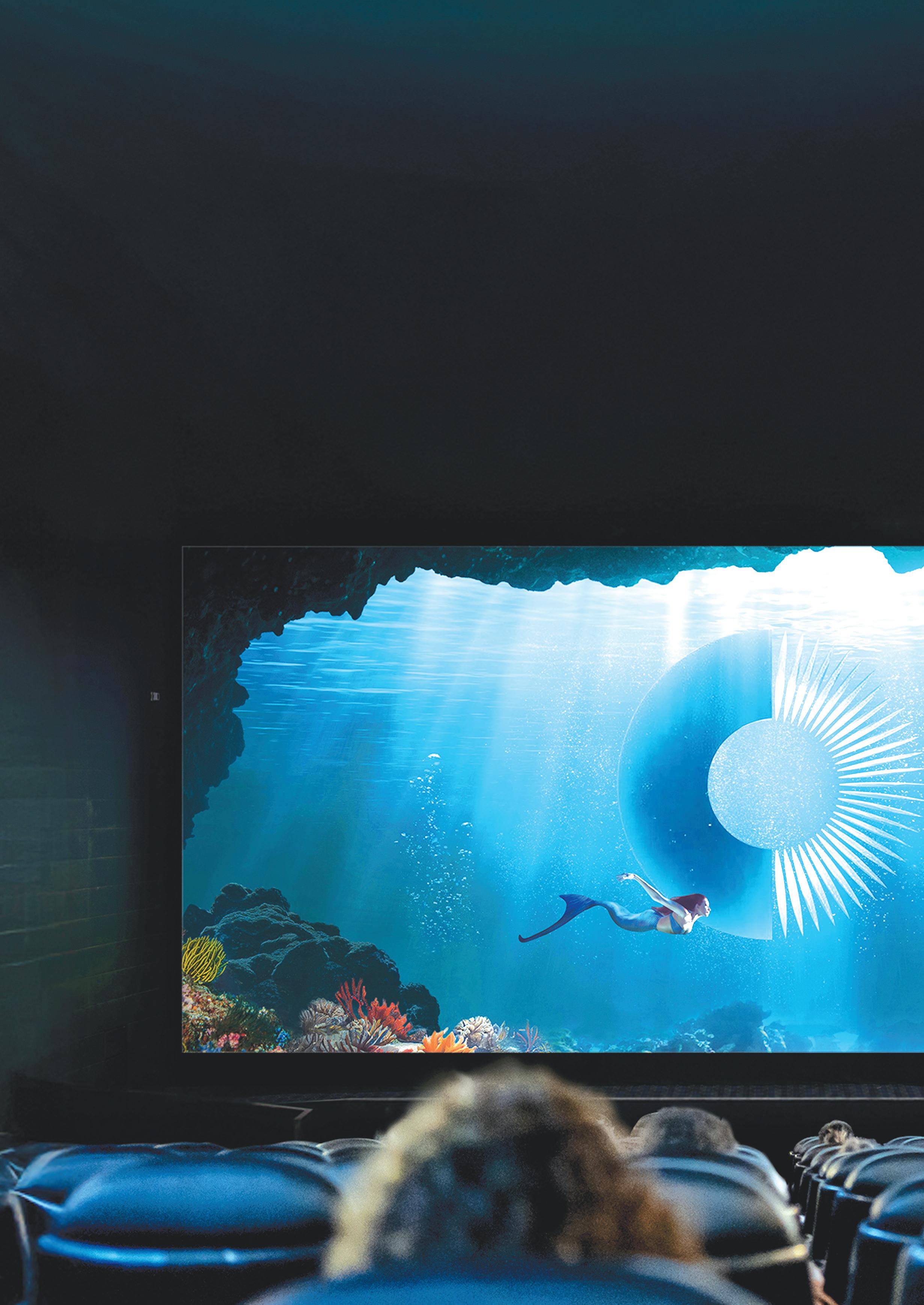
WORDS: PETER KNIGHT, COMMISSIONING EDITOR, CT MAGAZINE.
An update on the state of direct view LED cinema screens, exploring installations, product advancements, and exhibitor feedback.
It’s been some time since Cinema Technology Magazine last took a close look at direct view LED cinema screens. Our last in-depth exploration was two years ago, when we focused on LG’s early Miraclass deployments. At that time, LED screens were still largely considered premium outliers—impressive, but far from common. They raised interesting questions about the future of projection, but few would have predicted how quickly the format would begin to gain traction.
Fast forward to today, and that picture is beginning to shift. LED cinema may still be far from mainstream, but it’s no longer the outlier it once was. With more data, more installations, and more real-world experience to draw from, the conversation has matured.
It therefore seems a timely moment to assess how LED cinema has evolved—not just as a technical solution, but as a viable business proposition. With input from the sector’s two major players, Samsung and LG, along with

fresh context from CinemaCon, Cine Europe and other industry developments, this article revisits the subject to understand the current status of LED cinema screens and where things might be heading next.
By early 2025, more than 350 LED cinema screens were in operation globally. This figure, drawn from a combination of manufacturer data and market research, marks a significant uptick from previous years and reflects growing interest across the sector. Samsung, the earliest mover in this space, continued to lead with around 180 operational installations, while LG, having entered the market more recently with its Miraclass range, were reporting around 120 installations. Both companies have seen particular traction in Europe and Asia, with key deployments helping to shape wider perception of what LED can offer. While other manufacturers—including Sony, Unilumin, AOTO, and BOE—have LED-based cinema products in development or in early use, their footprint remains small by comparison. Many of these are limited to showcase venues or trial environments, with broader commercial deployment still some way off.
That said, 350 screens is still only a tiny fraction of the estimated 200,000+ digital screens operating worldwide. LED is not replacing projection at scale— but it is starting to find a firmer place in the mix, particularly in new-build premium sites and flagship refurbishments where differentiation is key.
What’s perhaps more telling is the shift in deployment behaviour. LED is no longer confined to technology showrooms or trial spaces. Increasingly, it’s being chosen for strategic projects in key locations—urban boutique cinemas, premium multiplexes, and high-traffic venues where image quality can offer a competitive edge. Operators are also beginning to build LED into long-term planning, rather than treating it as a one-off showcase.
Geographically, Europe has emerged as one of the most active markets, with high-profile installations in Spain, Belgium, Switzerland, and beyond. This reflects a broader trend among European exhibitors to embrace cutting-edge display technologies, particularly when paired with immersive sound or experiential content strategies. Analysts suggest that, should momentum continue, the number of LED screens could double within the next two years —a shift that would still be modest in numerical terms, but significant in terms of industry mindset and visibility.
Since launching its Onyx range in 2017, Samsung has positioned itself as the pioneer of LED cinema. With DCI certification and a steadily growing
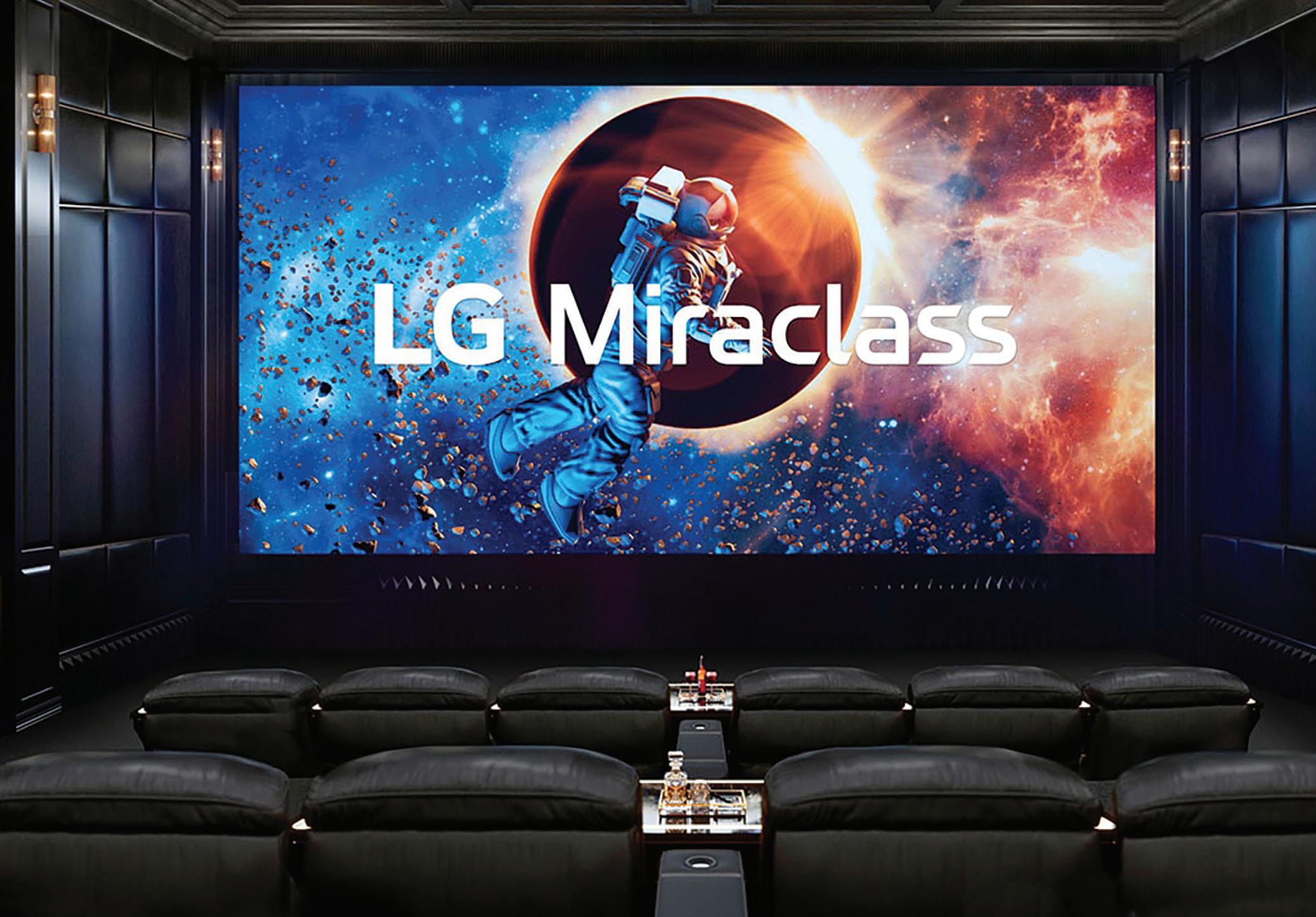
Europe has emerged as one of the most active markets, with highprofile installations in Spain, Belgium, Switzerland, and beyond.
under earlier product names. Installations were already underway prior to the formal announcement, with early pilot sites like Vilanova serving as testbeds for the product’s capabilities. Since then, the range has seen rapid adoption, particularly in Europe. One of its most high-profile installations is at the Odeon Multicines complex in Majadahonda, just outside Madrid. This became the world’s first fully LED cinema multiplex, with six auditoria fitted entirely with LG Miraclass screens. The three larger screens feature 55-square-metre 4K LED displays, each seating between 60 and 120 patrons, while the three smaller auditoria feature 14-square-metre 2K screens accommodating up to 40 guests. Each auditorium also includes Dolby Atmos audio and 3D capabilities. The site’s installation underscores LG’s confidence in its technology’s viability for both premium and mid-size auditoria. The screens utilise self-emissive LED technology with a 2.5mm pixel pitch, support for the DCI-P3 colour gamut, and 24-bit processing, enabling the display of over 68 billion colours. Brightness levels can be adjusted between 48 and 300 nits depending on the content and context. An energy-efficient Multi V climate control system from LG also helps enhance sustainability, reportedly reducing energy consumption by up to 40% compared to conventional systems.
Prior to the Madrid debut, LG had already installed Miraclass screens at
Odeon Multicines in Vilanova, near Barcelona. This earlier deployment served as a key pilot installation, demonstrating the technology’s performance in a live environment and laying the groundwork for the fully LED-equipped complex that would follow in Majadahonda. This installation was featured in Cinema Technology Magazine’s Autumn 2023 edition, providing readers with one of the first detailed looks at LG’s Miraclass system in action. These projects have established LG as a serious contender in the premium LED space and suggest further rollouts are likely as confidence in the format grows.
Audience reaction has been positive, with exhibitors citing high image quality, consistent black levels, and the visual difference from projection. LG also points to several practical benefits:
› Reclaimed projection booth space that can be repurposed
› Long LED lifespan (100,000+ hours)
› Modular design that simplifies servicing and replacement
› From a Return on Investment (ROI) perspective, LG acknowledges that cost remains a key consideration, but argues that these long-term operational efficiencies, coupled with the premium appeal, help support the business case.
Both LG and Samsung are clear: while the technology has matured, mastering content specifically for LED remains important. Standard DCPs will function, but they may not fully exploit the contrast and dynamic range that LED offers.
Samsung adheres to the DCI-specified HDR mastering standards for Onyx, supporting high brightness and contrast workflows appropriate for professional cinema presentation—while LG supplies tailored LUTs (Look-Up

At CinemaCon and Cine Europe, LED was a much more visible presence than previous years, and both Samsung and LG used the opportunity to showcase notable product advancements. Samsung showcased a 5-metre (16-foot base, 19-foot diagonal) version of its Onyx display and announced support for 14-metre screens in addition to the existing 5, 10, and 20-metre formats. While the 14-metre size was previously available in the earlier generation of Onyx, this appearance reaffirmed Samsung’s ongoing focus on scalable deployment options. The system supports 4K resolution at 120Hz for ultrasmooth motion and exceptional detail clarity— particularly useful for highaction content and event cinema. It delivers a uniform brightness of 300 nits across the entire screen surface— approximately six times brighter than conventional projection in terms of overall luminance—and a peak brightness of up to 500 nits for alternative content— and supports both scope (2.39:1) and flat (1.85:1) aspect ratios natively. Samsung also highlighted its automated calibration solution, which ensures optimal picture performance over time and simplifies maintenance workflows.
Meanwhile, LG presented the Miraclass LDAA030, designed to enhance brightness uniformity and offaxis viewing angles. The system features 24-bit colour processing capable of displaying over 68 billion colour variations, reproducing the full DCI-P3 colour gamut with precision. Brightness can
be adjusted across five stages, from 48 to 300 nits, allowing for flexible use cases including 2D and 3D exhibition, as well as corporate or alternative content. The screens also integrate seamlessly with Dolby’s Integrated Media Server (IMS3000), ensuring compatibility with professional cinema operations.
These product announcements underscore how far LED has progressed— not only as a display format, but as a configurable platform that offers exhibitors new tools for visual presentation, audience engagement, and operational control. Samsung’s flexible aspect ratio support and 10-year support programme for its latest Onyx screens demonstrate a mature product with a clear roadmap. Meanwhile, LG’s emphasis on colour fidelity, brightness flexibility, and compatibility with Dolby IMS3000 reinforces its commitment to delivering high-performance systems suited to a range of cinema environments. Both companies are clearly signalling that LED is not a fringe option, but a platform ready for broader integration across exhibition tiers.
Chinese manufacturers like BOE and AOTO previewed next-generation displays with AI-driven calibration and embedded audio modules, but these remain at the prototype stage.
Discussions with exhibitors throughout the event suggest that LED is no longer seen as experimental, but rather as an increasingly credible option for the right kind of venue—especially those targeting a premium experience or operating within a flexible, multi-use space.
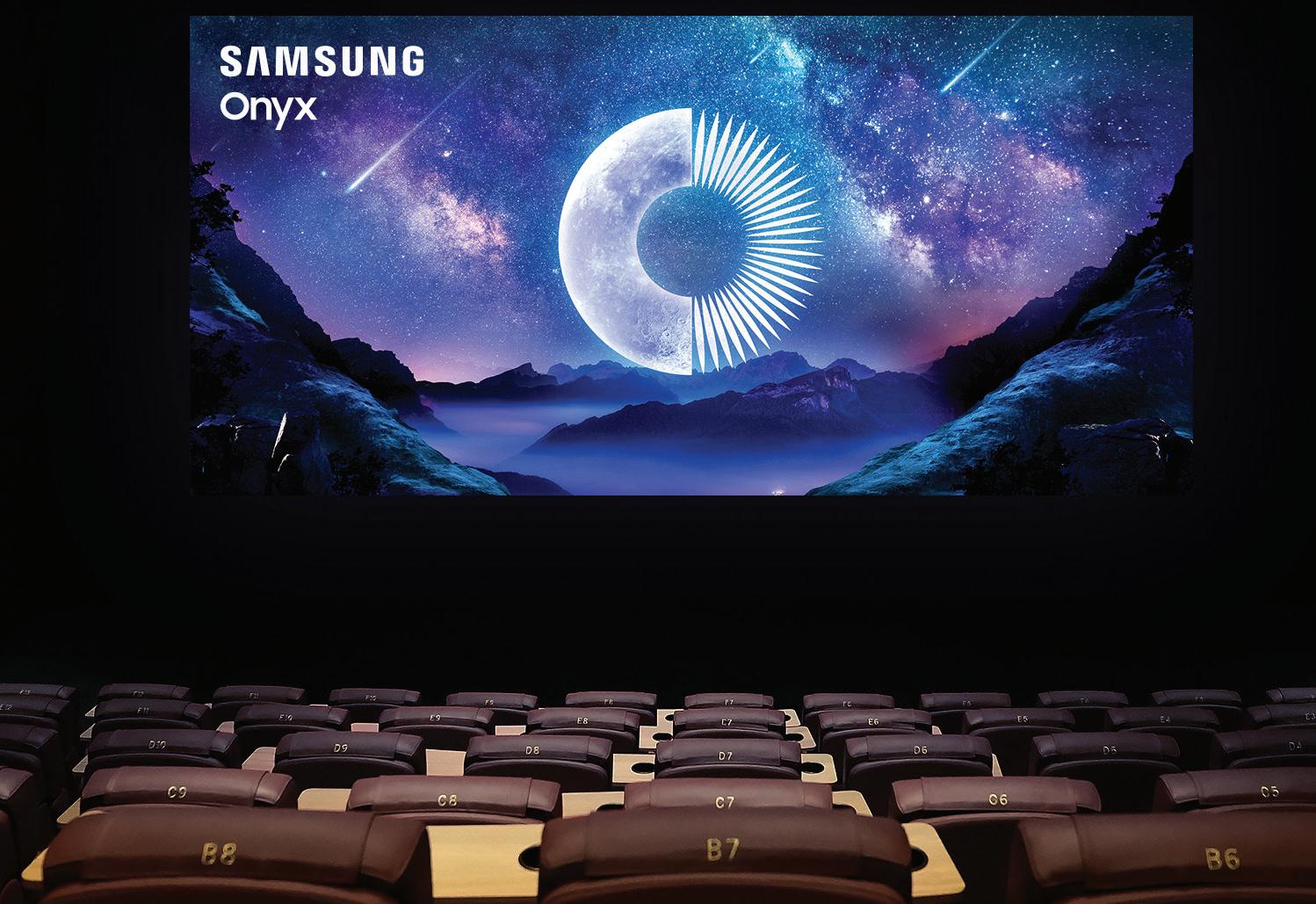
Tables), which are used to adjust and calibrate colour during content mastering. These LUTs are made available to post-production facilities on request and are designed to simulate Miraclass screen performance during the grading process. LG also supports cinema server integration to ensure consistent playback. Both manufacturers are working to support creative teams in adopting LED-native workflows. Samsung’s content validation tools, as well as ongoing studio collaborations, are aimed at standardising grading practices without disrupting existing pipelines. Training is also an emerging focus. LG offers onboarding support for technicians, integrators, and exhibitors, covering areas such as colour calibration, server configuration, acoustic setup, and LED-specific maintenance routines. These training sessions are designed not only to ensure optimal setup but also to build operator confidence in maintaining and managing LED systems independently. Samsung also provides structured onboarding and support through its global partner network, offering installation guidance and operational training as part of their integrator toolkit.
On the maintenance side, both report significantly lower servicing requirements than projection. With no bulbs to replace or optical alignment to maintain, operational downtime is reduced. However, audio integration remains a vital technical consideration. Because LED panels are not acoustically transparent like traditional perforated projection screens, exhibitors must position speaker arrays above or to the sides of the screen. LG provides detailed acoustic guidance for integrators, including configurations tested with Dolby Atmos systems. Samsung has worked closely with JBL to develop tuned speaker arrays that compensate for the lack of centre channel audio behind the screen.
In both cases, successful integration depends on early planning and technical precision—but the results can rival or even exceed traditional setups, particularly in purpose-designed spaces.
As LED cinema continues to evolve, its trajectory will be shaped by both its inherent technical advantages and the broader shifts within the exhibition industry. The unique characteristics of LED—uniform brightness, near-infinite contrast ratios, and pixel-level precision—offer a distinct viewing experience, especially in areas where visual fidelity is critical. For 3D content, where projection often struggles with brightness and ghosting, LED presents a compelling alternative with greater light output and minimal cross-talk.
Beyond visual performance, LED opens doors for flexible auditorium design. With no projection booth required, operators can rethink seating layouts, auditorium shapes, and even repurpose that valuable space for enhanced food and beverage offerings or premium lounge areas. This architectural flexibility is particularly valuable in new-build multiplexes and urban locations where real estate is at a premium.
Operators are also recognising LED’s potential to support diversified content strategies. The brightness, resolution, and reliability of LED displays make them well suited for alternative content beyond Hollywood features— such as gaming tournaments, eSports events, live concert screenings, or high-profile corporate launches. These use cases not only drive additional revenue but help future-proof cinema venues against single-stream dependency.
However, the path to broader adoption isn’t without challenges. LED screens remain a significant upfront investment, and while maintenance costs are lower, the ROI still depends on careful positioning within a venue’s business model. Audio integration continues to demand thoughtful design,
Operators are also recognising LED's potention to support diversified content strategies.
and content mastering workflows are still catching up to LED’s capabilities. There’s also the question of standardisation—particularly around HDR formats, content delivery, and certification. That said, signs of maturity are emerging. LG’s integration with Dolby’s IMS3000 reflects a shift from novelty to reliability. The arrival of custom calibration tools, LED-native workflows, and integrated support ecosystems suggest that LED cinema is being taken seriously not only by manufacturers but by studios and exhibitors alike.
As costs gradually decline and awareness among creative and technical professionals grows, it’s likely that LED’s appeal will expand beyond high-end sites. Mid-tier and independent cinemas may find niche applications— particularly where flexibility and space-saving design bring tangible operational benefits.
For now, LED remains a premium option. But its role in shaping the next chapter of cinema presentation is becoming more defined—and increasingly, more difficult to ignore.
Eight years ago, a single screen in Seoul redefined the conversation about cinema presentation. Today, with over 350 installations worldwide, LED cinema screens are becoming part of the landscape. Not ubiquitous, but no longer quite so niche.
Samsung and LG remain the key players, each with their own strengths, and their continued innovation will shape how the format develops. While projection still dominates, LED now has a firm foothold.
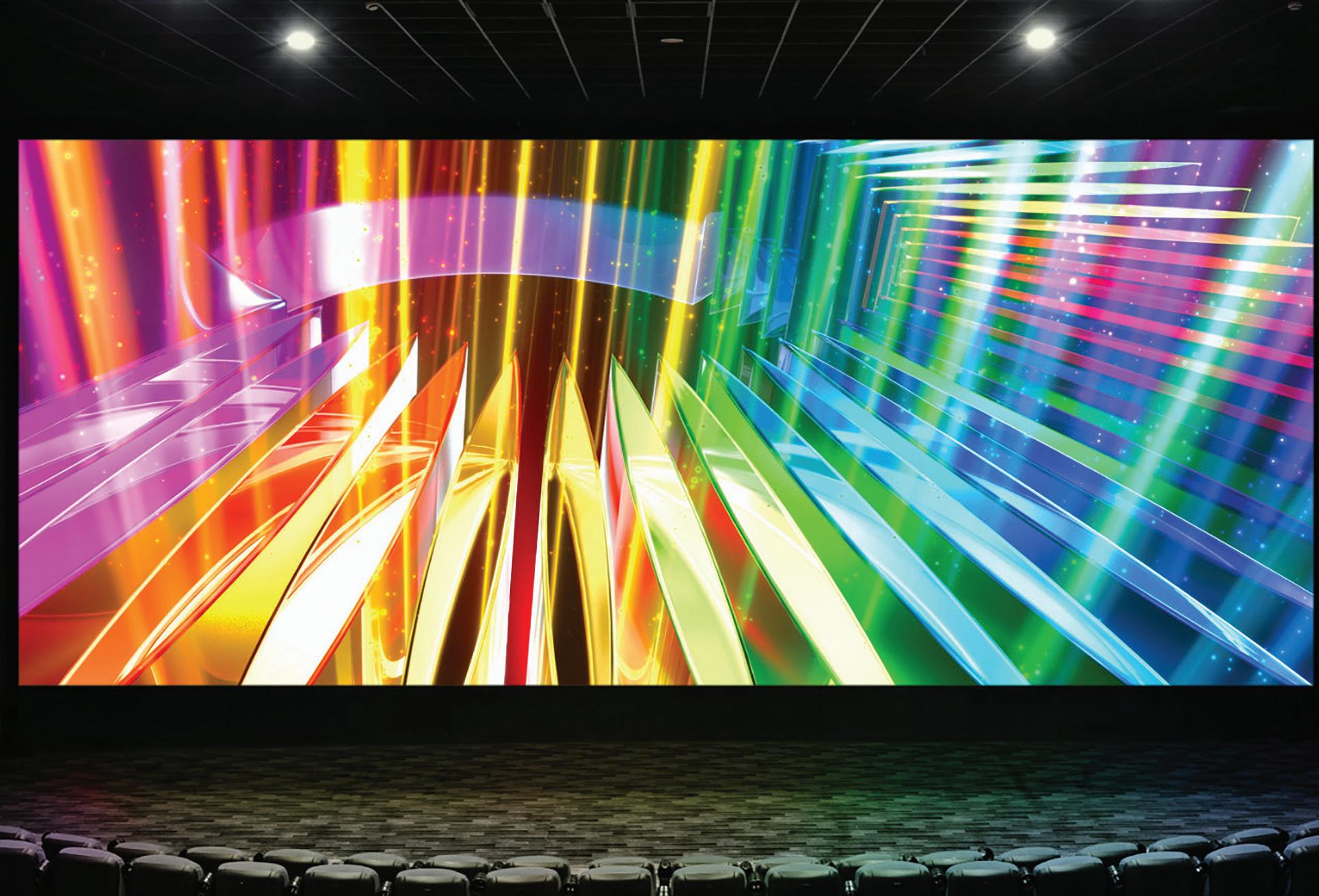

ANSWERS BY KOMMER KLEIJN AND PETER WILSON.
After the publication of the three previous parts to our series in Cinema Technology Magazine, we have received some reactions and questions from readers. Here we seek to provide you with our answers.
If we imagine a situation where most cinema auditoriums and most mastering and grading rooms would be equipped with RGB laser projection, wouldn’t that solve all these metamerism issues?
An understandable question for which the answer unfortunately is no. There are several reasons...
It would possibly help with only one of the metamerism problems (the perceived white point difference) but only that one. And then only if all the RGB laser projectors would be the same, which they are not. The other two metamerism problems are related to individual differences between viewers, so then even having the exact same RGB laser projectors everywhere would only mean that the person that graded (mastered) the movie would see the same thing in the theatre. But only them. The main problem with RGB laser light is that it makes the consequences of the differences between individual people more important, both those due to genetics and those caused by age. So even if all projectors were to be the same, we will still not be able to predict what the patrons will see as this now also depends on their age and individual genetics. With Xenon illumination, these individual differences are also present, but play a lot lesser role to an almost insignificant degree. RGB laser amplifies the effect of the individual differences.
Additionally, not all laser projectors are the same. First, we have RGB laser and laser phosphor projectors. The latter behave much more like Xenon. But then even RGB laser projectors come in different
“flavours”, that is, versions, where the wavelength of the RGB primaries are not the same. So even for the same person, there are differences perceived from one laser RGB projector versus another. These differences occur between different brands and models, and sometimes even within a same model, during the production. We can sometimes see changes in primary colour wavelength depending on what laser diodes were proposed by laser diode manufacturers at the time of projector assembly. Theoretically this was not supposed to make any visual difference, the difference in wavelength is taken into account by the projector software when calculating the RGB steering values from the XYZ colour data in the DCP. This software, however, is based on the CIE1931 colour theory, which we now know is not actually applicable to narrow band laser light. In fact, the metamerism failures may be different for each of these versions of RGB laser projectors.
And finally, we also see other problems, besides the metamerism. Like speckle and red colour fringing, which are not related to metamerism. Having RGB laser everywhere will not solve these either.
If we imagine RGB Laser light projection to become mainstream, maybe we will all become used to it; maybe our eyes and brains will adapt to it and then the problem goes away?
Unlikely. First, for our organism to adapt to a new environment takes a very long time. Only once per
generation a small evolution takes place. But also, for the Darwin theory to apply, it would need to be linked to survival. This seems not to be the case here. People not seeing the colours correctly will not kill them nor harm their reproductive capabilities. It will just harm the cinema industry. Additionally for most of us the time spent in the cinema is not significant compared to time spent elsewhere. If we would replace the sun with laser light so we would be in it all day, then maybe we would adapt after a few thousand years?
I read all those problems, including some for which no solution is in sight. Does that mean laser is a NO-GO and that we all need to keep (or return to) Xenon?
Our opinion is that there is a solution available with laser excited Phosphor, the so-called phosphorlaser projector or laser-phosphor projector. The ones proposed with two phosphor colours (RG) and one direct laser colour (B) do a good job and yield results that are close to that of Xenon light. It is also possible to make even better phosphor-laser projectors that have all three primaries generated by laser-phosphor. These are already available in the event market but not yet for D-cinema. These have all the practical laser advantages over Xenon, like longevity and low power consumption, but without causing any of the new problems outlined earlier. It is possible to make a phosphor laser projector that has the same wide band spectral power distribution that a Xenon projector has, so that

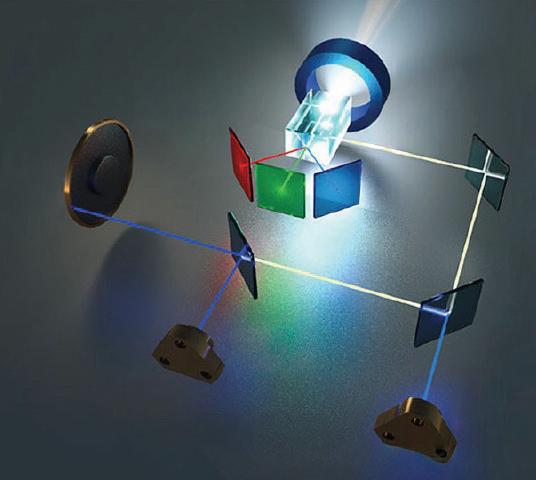
none of these problems arrive as these are almost all related to the narrow bandwidth RGB primaries used in RGB laser light. Additionally, laser phosphor projectors tend to be cheaper than RGB laser as the colour of the laser itself becomes less critical, allowing manufacturers more choices among cheaper and more efficient laser diodes.
Today, projector manufacturers seem to promote RGB laser over Phosphor-laser. Aren’t there then any disadvantages on Phosphor laser compared to RGB laser?
Unfortunately, yes, but these are we believe minor drawbacks. The transformation process from laser light to phosphor light does consume some power/ light. So slightly stronger laser diodes are needed for the same light output. But they are cheaper to buy because their colour is not so critical. Also, often the power consumption is hardly affected as the manufacturer can choose lasers with a higher efficiency given the larger choice of possible laser colours (in a phosphor laser projector, the laser provides the light power but the phosphors determine the exact colour). Then there is the wearing of the phosphor wheel. Output power may reduce over time when the phosphors on the wheel wear out. This is, however, reasonable. Many phosphor laser projectors are good to run their entire life on the same phosphor wheel. Alternatively, the phosphor wheel can be replaced. On some projectors the user can do this in the field. On those projectors this change is easier to do than to change a Xenon bulb. But no worries, phosphor wheels have a much longer lifespan than Xenon lamps. If one phosphor wheel is not enough for the lifetime of the projector, the wheel may need to be changed only once or twice during the projector’s lifetime, if at all.
WON’T
Maybe, but not without corrective action, because the problem currently is the same, including the possible solutions. Unfortunately, the direct view screens that are currently proposed use narrow band RGB LED primaries and thus present all the exact same problems as RGB laser does, except for speckle. But with the use of narrow bandwidth RGB LEDs, the other problems persist with most actual LED screens, including the metamerism problems and red fringing. But again, there is a solution, which consists of using phosphor LEDs. In this case this is even more attractive than with projectors: Phosphor LEDs are already widely used in lighting fixtures, so the technique is well known. And there is no wear disadvantage to phosphor LEDs as with LEDs the power is distributed and not concentrated as is the case in a projector, so Phosphor LEDs have less wear, do not need replacement, and do not have the power disadvantage as is the case with phosphor wheels in projectors. The use of phosphor LEDs could make direct view screens perfect without significant drawbacks.
The use of phosphor wheels or phosphor LEDs, doesn’t that restrict the possible colour space?
Yes and no, or yes, but not in a very significant way. Straightforward use of phosphor will allow for P3 colour space, the same as with Xenon. As with Xenon, if need be, a notch filter can be used. It is true that RGB laser and RGB LEDs can in theory reproduce more saturated colours than P3 can, but first it is debatable if is such is actually useful or desired, and then, if it were, there are also solutions available, while keeping the use of phosphors, that allow for a wider colour space without using narrow bandwidth primaries or creating the problems that were outlined earlier. For obtaining a wider colour gamut, if ever that would become a
need, narrow bandwidth primaries are not the only possible path to obtain that. And as we have now learned, using narrow band primaries causes a host of undesired effects, these other methods may become more attractive.
Won’t the wider colour space of RGB laser make all colours look better?
No, that is not the case. What a wider colour space allows for is the possible reproduction of some highly saturated colours; colours that are more saturated than the most saturated colours a P3 Xenon projector can reproduce. For one, these “new” colours are highly saturated colours that rarely occur in daily life, but more importantly, these colours do not currently occur in mainstream movies. Indeed, only few specific DCPs exist at this time that use some of these additional colours that RGB laser projectors can show and that Xenon or phosphor projectors can not. So for the time being, there is no general benefit from RGB laser, colour quality wise. Aside from the metamerism issues the colour result showing a standard DCP is supposed to be exactly the same on RGB laser, Xenon, UHP or phosphor-laser. But to the contrary, several patrons do not see the colours correctly due to the metamerism failures. So all in all, the colours of a Xenon or phosphor-laser projector are actually better and more accurate in relation to the film maker’s intentions.
But with television it seems that REC.2020 UHDTV looks better than traditional HDTV, is that right?
Yes, this is true, but first we must note that in television the new wider UHDTV colour space (REC.2020) makes a much bigger difference with the previous one (REC.709) than is the case for D-cinema because D-cinema already uses a much wider colour space from its inception point. If the difference between REC.709 and REC.2020 can be quite big, digital cinema already uses a much wider colour space than REC.709, namely P3, so the difference between D-cinema P3 and REC.2020 is smaller, and therefore, also not as desirable as is the case for TV. You can also see it as we already have a sort of WCG (Wide Colour Gamut) in D-cinema, so pushing it a little further with REC.2020 would not make as much a difference any more. Especially so if that also creates a host of new problems. Secondly, another reason why REC.2020 is more important for TV than it is for cinema is because
today the HDTV file and transmission encoding is limited to REC.709, which is not the case for D-cinema.
D-cinema uses XYZ encoding which covers all colours that can be seen, even beyond REC.2020. HDTV however, uses REC.709 encoding so even if we wanted to show D-cinema P3 colours on a TV screen, we can’t do that with the actual REC.709 HDTV encoding standard. This is where UHDTV with the REC.2020 encoding comes in. We should see REC.2020 in TV mainly as an enhanced encoding standard for TV, for example to be able to transmit or distribute movies to the home using their original P3 colours on UHDTV screens. This is possibly much more significant than a need to present the actual REC.2020 colours themselves which do not occur in mainstream audio-visual work at this time anyway. But P3 does! So the fact that REC.2020 is important for progress in TV concerns mainly encoding and this is not needed for cinema as D-cinema already has a “wide” encoding method called XYZ, which even surpasses REC.2020. As such, and using P3, we can argue that D-cinema already operates with Wide Colour Gamut encoding, and therefore has a lesser need for upgrade, if needed at all.
Do the problems you describe in your article apply to modern televisions as well?
As far as we know, no commercial TV achieves a 100% of REC.2020 colour reproduction or uses monochrome primaries, but this is coming too. UHDTV makers are putting efforts into trying to make their panels reproduce colours as close as possible to REC.2020. Top of the line TV’s now cover up to 90% of the REC.2020 colour space (and 100% of P3). However, they do this by narrowing the bandwidth of the primary colours so they are also getting the problems we described for laser projectors, although with a slightly less intensity.
The contradiction is that TV manufacturers (and many review web sites) are convinced that wider than P3 colour gamut is better while we now know that in fact it causes a host of troubles that can alienate the benefits when it is realised using narrow bandwidth primaries.
First off, UHDTV sets are capable of showing REC.2020 encoded content. 4K blu-ray discs can use REC.2020 encoding. But using REC.2020 encoding does not necessarily mean that the panel or tile (the actual display) can display all REC.2020 colours or is using narrow band primaries.






The UHDTV standard mandates the use of REC.2020 encoding. This is very useful as it allows for encoding movies with their original P3 colours on 4K blu-ray, something REC.709 encoding does not allow for. Quite a few actual UHDTV displays can show P3 colours now. REC.2020 encoding is needed to use that. So this is what we would want. An UHDTV supporting REC.2020 encoding in order to display P3 colour space.
Recently (24 Jun 2025) the EBU held a webinar on the subject of metamerism with narrow band primaries. It contains interesting presentations by top vision research scientists, and is worth looking at. (For a recording of this webinar see: https://tech.ebu.ch/ publications/presentations/2025/20250624_wcg_ metamerism_webinar/ why-do-people-perceive-colours-differently-onwcg-displays)
O.K. I now understand that “widerthan-P3” colour space is not of much use in the cinema theatre today. But could it become useful in the future?
Maybe. It is possible that it might eventually become useful in combination with strong HDR (Strong High Dynamic Range). Strong HDR is a new, at this time still experimental technology that allows for highlights of 300 Nits. When such strong highlights are used, in the areas of those highlights, these highlights get, because of their strong luminosity, a lesser-perceived
saturation. The question has been raised if using a wider colour gamut will allow re-saturating such highlights. However, the usefulness of this in storytelling has not yet been established, as the less saturated appearance of these highlights also corresponds with how we perceive these kinds of highlights in real life. So more experimentation and research is needed to establish the eventual usefulness of these added colours in storytelling, even with strong HDR. If it turns out to be useful, and supposing strong HDR were to become common, then there are also other technologies that can be used to create additional colours without the use of narrow bandwidth primaries.
What about grading suites. Do you recommend mastering studios and grading suites to switch to RGB laser?
No, they should probably keep their Xenon projectors, even if the graded movie will only ever be shown on RGB laser projectors. This may seem contradictory but please let us explain. The main problem with RGB laser light is a form of incompatibility with the human visual system causing individuals to perceive a different result depending on their personal genetics and age. This creates a form of uncertainty. We can not predict with any level of precision what the patrons will see, as with RGB laser light uncontrollable factors come to play a significant role. This uncertainty comes into play in
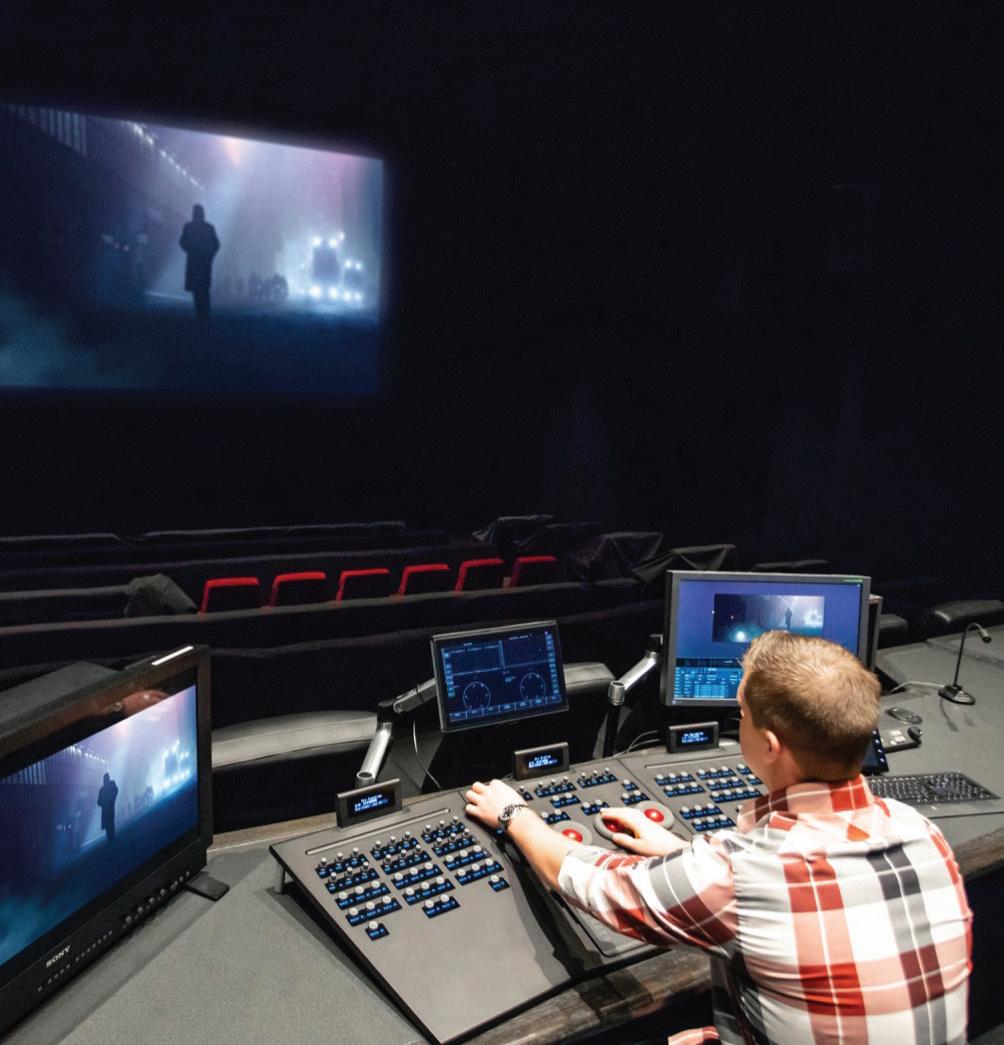
the theatre where the RGB laser source is installed, supposing we are certain about what is written in the DCP. However, if we also use an RGB laser projector during grading then we lose control over what will be written in the DCP as well, since now the individual genetics and age of the grader will influence his or her decisions and subsequently the values written in the DCP. Unless the grader has the same genetics and age as all the patrons in the cinema, which won't be the case, grading on an RGB laser will thus add additional uncertainty and error rather than correcting any.
Otherwise explained: The question makes a lot of sense if the RGB laser projector would simply be “different” from Xenon. Then using them both in both situations would make things better. The reality, however, is that RGB laser, due to its incompatibility with our visual system yields unpredictable results. This causes a lack of reliability in what the viewer will see. The perception becomes unreliable. Putting an RGB laser projector in the grading room as well as in the theatre would add a second unpredictable situation, and is therefore likely to worsen the situation.
What about DCI and SMPTE, do they endorse RGB laser projection?
DCI (Digital Cinema Initiatives LLC) is a consortium that was formed between seven Hollywood studios
in 2002 to establish a common specification between them for digital cinema. Once they agreed on a common minimal specification, they submitted this to SMPTE where also demands from other entities (like manufacturers and trade bodies) were received, for SMPTE to create an International standard based on all the collective needs. Once the standard was established the idea was that DCI would dissolve, but that never happened. SMPTE standards, ratified by ISO are now the official authoritative standards, but in practice many manufacturers are still looking at DCI, while DCI is not, in fact, a recognised standards body. Now coming back to your question, the answer is yes, DCI has repeatedly certified both RGB laser projectors and narrow band LED direct view screens as “DCI complaint”. It looks like they did so by measuring these projectors and screens using metering systems based on the standardised CIE1931, but now known as obsolete colour science and - supposedly - without attentively examining the presented images. So by missing out on metamerism and other issues, they in some way missed their original goal which was to assure that the perceived images in commercial cinemas would conform with what the Hollywood filmmakers had intended. By using the outdated but still standardised measuring methods that are based on 1931 colour science and were tested with
lamplight only, the perception errors caused by narrow bandwidth primaries go unnoticed during the tests. The result is that this equipment is certified as “conformant” while it is not actually yielding the desired, intended and promised result.
Also at SMPTE there does not yet seem to be much reaction to the issues RGB laser and narrow bandwidth LED cause. As explained in the article about the “broken” CIE1931 standard, neither DCI, SMPTE or ISO seem to react to this issue for the time being, meaning that RGB laser projectors, as well as narrow bandwidth LED direct view screens are measured against the now probably obsolete standard and pass certification, while in fact they do not reliably produce the desired visual result. So yes, apparently both the DCI specification and SMPTE/ISO standardisation may need revision.
Does all this really matter? Maybe the patrons may not notice these problems anyway, or do they? Does this all actually impact the cinemagoer or the industry in any way practically?
Chances are it does. While it is often argued that common patrons do not see, are not aware or are not bothered by presentation imperfections, that belief is often based a low number of complaints. However, the reason we seldom get detailed complaints from patrons is not because problems do not bother them, but this is rather due to the fact that the average cinemagoer does not have the technical knowledge or expertise to specifically recognise and describe a particular problem with image or sound. This keeps them from complaining, but that does not mean that the customer was not dissatisfied by the problem. Technical problems do dissatisfy customers. They will know very well that the presentation was not optimal but since they often do not have the technical skills to describe what the problem actually was, they prefer not to signal it, because they would be embarrassed if unable to describe it precisely. Additionally, signalling a problem is also perceived as a burden. It takes energy and time to complain while most people come to the cinema to be entertained and relax. The absence of complaints must therefore not be interpreted as a proof of satisfaction. The important thing, however, is that if they are dissatisfied, it is because they had a lesser experience. And that does influence their overall satisfaction, which in turn influences the delay for
coming back to the cinema. If very satisfied they will return sooner, if less satisfied they will most likely return later. And that has direct consequences for the success of our industry.
How can a patron be bothered by metamerism failure without prior knowledge about how the movie at hand was supposed to look?
For metamerism failures the issue is indeed even more complex, because one could argue that it is impossible to note the problem if you are not involved in the making of the movie at hand, or at least saw the movie earlier on a larger bandwidth (Xenon or Phosphor) projector. Metamerism failures cause colours to be perceived differently from the filmmakers’ intention. A patron could never be able to know that because even if colours are perceived incorrectly, he/she has no knowledge of how the colours were supposed to be… So no problem!
True but that is without considering the enormous attention, care and precision that filmmakers invest in the establishment of the exact colours in movies.
While it is often argued that common patrons do not see, are not aware or are not bothered by presentation imperfections, that belief is often based a low number of complaints.
task. Metamerism issues make that these carefully constructed colour schemes can then be perceived differently as intended with the result that the emotional power of the movie piece is diminished. Although the patrons would not be aware that the piece was not correctly seen, and that the emotional power of the movie was lower as intended, still he/ she had a less intense experience, as part of the filmmaker’s creation was not delivered in full. As a result the overall satisfaction may be lower which may result in a longer period before the patron will come back to the theatre.
They do this in the function of storytelling, which is the core of emotional pleasure we communicate through the cinema medium to the viewers. By creating precise ambiences and by precisely adjusting skin colours, the emotional power of the story is greatly enhanced. Artists in the film crew like the Director of Photography, working close together with the Director, Production Designer, Wardrobe and Make-up, and also Colour Graders are specifically trained for and are charged with this
Note that besides screen size this is also one of the reasons why movies are felt stronger and more intense in the cinema than they are experienced on a TV screen. This is not only due to the screen size. Indeed, commercial TV screens do not have that same degree of precision that a good DCP presentation can provide. We think it is useful and important to cherish and preserve that power of precision of the cinema medium. For the maximum emotional pleasure of the patrons and by consequence, for the success of our industry.

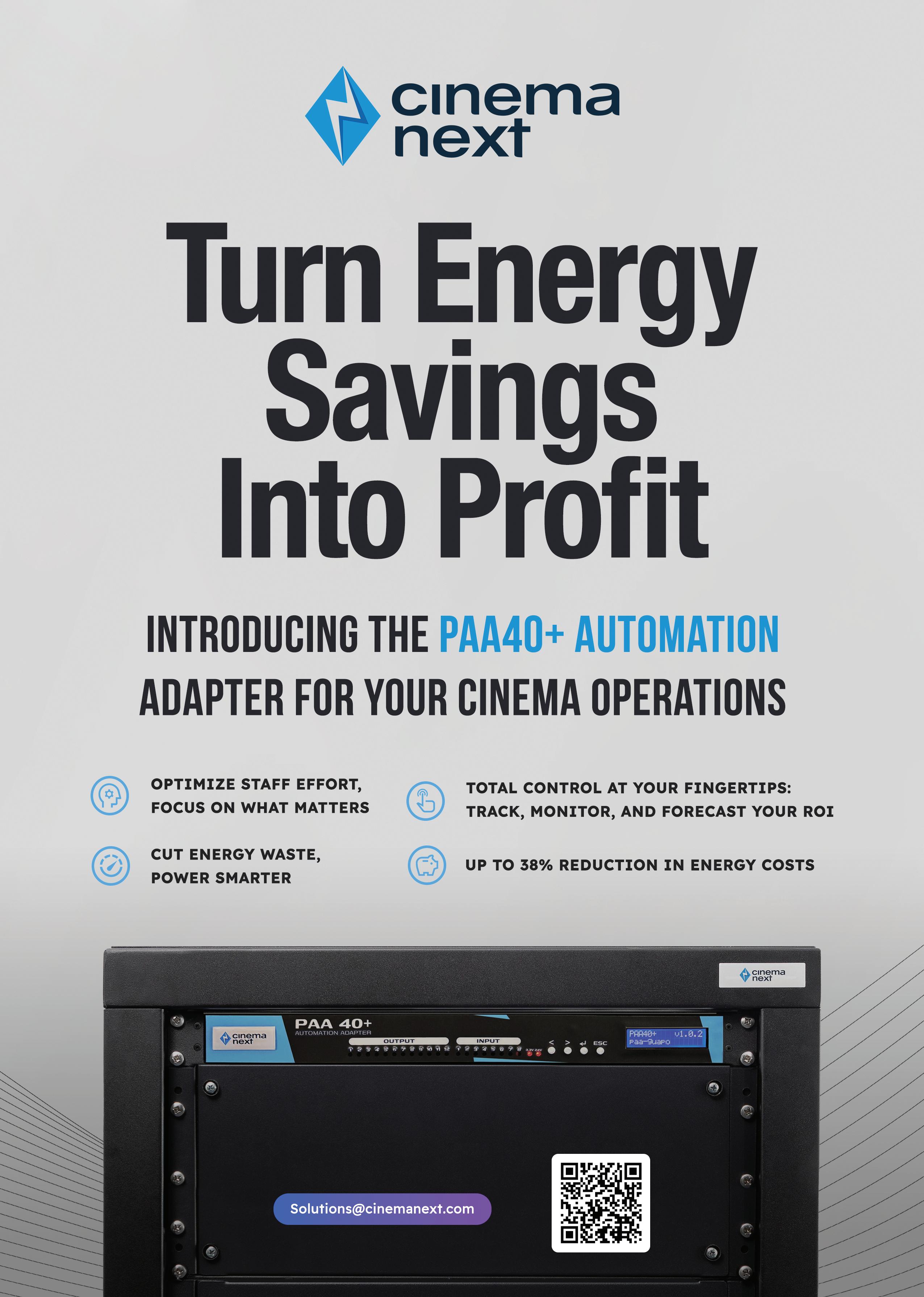

We left the last instalment with an idea that workflows are actually getting far more complex due to multiple versions, object-based media, content provenance requirements and other deliverables being stacked up. So we need to take a leap into the future and do a bit of prediction which means from now on, to take a quote from Dumbledore (Harry Potter book six) “From here on in, Harry, I may be as woefully wrong as Humphrey Belcher, who believed the time was ripe for a cheese cauldron”! To make sure I minimise my inevitable embarrassment, let’s just look at four bite-sized chunks.
To start with, a topic I am very passionate about, and one area I haven’t mentioned so far - Accessible Media! This is often a cause of concern for programme makers and one of the most common areas of complaint from the audience. Making accessible programmes has always been controversial, I’ve been in an edit suite where a producer has commented that the money for accessibility was a waste and would be better spent on the programme – an upsetting attitude but unfortunately, it still exists.
The good news is that all of the developments in programme workflows have made the accessibility process much easier to handle.
However, we have moved on and audience expectation has also changed dramatically. When we talk about accessibility, the common perception is just subtitles, however, audio description is growing, and signing, albeit often relegated to late night “signing zones”. These services are part of what makes media truly accessible.
Accessibility is more about personalising media “to meet my needs”. The ITU like many others is looking at accessibility from the expectation of the audience. Based on the development path of current workflows into object-based workflows, it will be possible to extend the many elements of a programme to the receiving device. Within
parameter limits set by the production, the user will be able to adapt how the programme is reproduced. Now – before I hear “creative intent”, I will remind you of Jamaica Inn (Jamaica Inn ends with 2,200 complaints about mumbling - BBC News) – no matter what the intent is, if you can’t see it, hear it, take part in it or understand a programme, it has no value to the person that needs it! The idea of content adaptation is about the audience Quality of Experience. If we can use all the tools to maximise the QoE though a personalised experience, then we all gain. As an example, a group called “Can I Play That” (Can I Play That? - For Disabled Gamers, By Disabled Gamers) is having success in the gaming world.
A user could be presented with a set of parameters that can optimise the experience based on personal preferences and the capability of the device they are using. My thoughts for the future are based on the current development path
of object-based and componentised content, the combination with AI/ML driven workflows and processing that is already happening in many areas. It is also based on the continuing development of hybrid delivery systems such as
ATSC 3.0, Brazil’s new TV3, the next iteration of DVB-I etc. All of this will enable the expansion of content accessibility to reach the 100/100/100 target - that is 100% of content on 100% of devices at 100% QoE.
The potential for accidental distribution of misinformation and disinformation by a broadcaster puts at risk the trustworthiness of broadcasting. The EBU states that “What is needed is a strong focus and commitment to implement solutions that guarantee the authenticity of content and track the provenance of content along the chain of content production and exchange”. https://tech.ebu.ch/publications/ tc-statement-2024-08-15-on-content-provenanceand-authenticity
Content provenance is becoming a very big issue, just how can you tell if legitimate content carrying the branding of a trusted source has not
When you think about virtual production, we usually mean green screen or LED walls etc, but here I am thinking about virtual radio and TV studios, about virtual OB trucks and about live or as-live multicamera programmes. There is already an example of a semi-virtualised studio networks that’s been running for over 10 years ago - the BBC Virtual Local Radio (ViLoR) BBC introduces ‘virtual’ Local Radio stations - Media Centre.
It's technically possible now, (and has been for a while), to build a totally virtual “cloud-based” live TV/Radio station with virtual studios, playout and distribution systems. The issues that slowed development, was the reluctance to use these
been changed by others? This is where standards such as C2PA (Overview - C2PA), It’s a new and complex area that will be added to the workflow of many programmes.
There is a fairly easy to understand video on the Project Origin website, but how this will be practically implemented without time and cost, is still in the early stages. Although the video focuses on live news and web content, the use of material in documentaries and other fact based programmes, means all workflows need to handle and pass the provenance data with the ability to append and add new at any (or even every) step, on to the end user.
As an example, a BBC R&D article looks at a simple stills workflow which shows how apps that support C2PA actually work together –worth a quick read Is this real? Provenance in generative media.
My thoughts for the future, are that future workflows will store data for each process step of a piece of media – where and when it originated, which applications processed it, what did the applications do, who authorised the processing… All the data will be available at each stage of production and the “provenance” data for all content will be available to the end user.
systems. One guess when that changed! But we aren’t seeing mass migration, what is happening is productions are created in local hubs when and wherever needed.
THERE IS ALREADY AN EXAMPLE OF A SEMIVIRTUALISED STUDIO NETWORKS THAT’S BEEN RUNNING FOR OVER 10 YEARS AGO - THE BBC VIRTUAL LOCAL RADIO (VILOR) BBC INTRODUCES ‘VIRTUAL’ LOCAL RADIO STATIONS - MEDIA CENTRE.
The control areas could be anywhere or more practically, able to connect to any floor space in the facility as needed. OBs can run split setups with minimal location rigs.
Productions can choose how they work and call on applications of services on demand (preferably pre-booked for live programmes!) but without the hassle of transporting, rigging, setup, de-rig and return! An interesting area that virtual live production could benefit is the link between theatre or smaller venues and cinema. Take these ideas just a little step further and every performance venue could stream UHD/HDR to cinemas. Using permanently installed cameras and applying object identification technology to drive close up cameras alongside locked off wide shot cameras, add a secondary audio mix using the stems from the venue sound and using something like Mavis' cloud system (opposite) with a pay-per-use model, many options become viable!
My thoughts for the future on remote production are a little more difficult as I am pretty sure by the time you read this, some of this will be business as usual! The future direction of remote production will depend more on development of other technologies like virtual cameras, volumetric sound and picture capture and headsets used in production.

really enjoy each new territory. Each one is so different, they work differently, films release differently. So it’s always exciting for me to learn something new.
really enjoy each new territory. Each one is so different, they work differently, films release differently. So it’s always exciting for me to learn something new.
My main expansion into the role has been to take on some bigger picture business, hopefully relieving some stress from my boss.
My main expansion into the role has been to take on some bigger picture business, hopefully relieving some stress from my boss.
CT: How have your previous experiences prepared you for your new role?
CT: How have your previous experiences prepared you for your new role?
I think because I’ve been so lucky to have had a varied career. From being on the studio side to growing in the tech side. I feel i understand the pain points that my customers face. Because I faced them.
Finally - workflows are getting more and more complex and are more and more oriented to data driven processes. A while ago I became a bit unpopular by suggesting data was becoming more important than the sound and pictures it’s associated with – Well, what I actually said was, “we are fast approaching the point where sound and pictures are just ancillary data in the content workflow”!
I think because I’ve been so lucky to have had a varied career. From being on the studio side to growing in the tech side. I feel i understand the pain points that my customers face. Because I faced them.
CT: As the newest member of the CTC board, what are you looking forward to most?
CT: As the newest member of the CTC board, what are you looking forward to most?
Oh my gosh, the community. Sharing knowledge between this group of incredible people across the globe. Looking for better ways to work together that can help anyone. I hope I can bring something valuable to the table.
QUBE WIRE CINEMA, A LEADING PROVIDER of end-to-end digital cinema technology solutions, has signed a definitive agreement to acquire a 100% stake in MetaMedia (MMT Tech, Inc). MetaMedia is North America’s largest cloud-based content delivery platform to cinemas. With this acquisition, Qube Wire becomes the world’s largest cinema electronic delivery network with over 5,000 cinemas connected across 51 countries. In the United States, the merged network will provide coverage to 9 of the top 10 largest cinema chains. Qube will continue to execute MetaMedia’s existing deployment plans and service its customer agreements.
Oh my gosh, the community. Sharing knowledge between this group of incredible people across the globe. Looking for better ways to work together that can help anyone. I hope I can bring something valuable to the table.
With this in mind and as AI is rather good at dealing with data, my last thoughts have to do with what AI could be up to in workflows – no matter what we think it’s doing or more accurately, what it thinks it’s doing. Starting with the current Software as a Service model, there are several articles on what the current thinking is on what will replace SaaS. The trend seems to be towards Agent as a Service (unfortunately – AaaS). Which shouldn’t be confused with the other AaaS - Authorization as a Service!
“The acquisition of MetaMedia is a huge move for Qube’s North American operations,” said Harsh Rohatgi, CEO of Qube Cinema. “MetaMedia’s
Artify -Sonakshi Pattnaik (Medium web article) writes “AI agents are specialized applications that use advanced AI models, such as GPT or LLaMA, to
“...Sharing knowledge between this group of incredible people across the globe. Looking for better ways to work together that can help anyone. I hope I can bring something valuable to the table.“
“...Sharing knowledge between this group of incredible people across the globe. Looking for better ways to work together that can help anyone. I hope I can bring something valuable to the table.“
I’ll end on two pieces of advice I was given when I started, and I love to share them as I believe they are so invaluable.
I’ll end on two pieces of advice I was given when I started, and I love to share them as I believe they are so invaluable.
two primary archive use cases – sales/repeats and use of selected content in other programmes. With a payment/PO option it can handle all the finance transactions at the same time.
CT: What’s your favourite aspect of working in the cinema industry?
CT: What’s your favourite aspect of working in the cinema industry?
The cinemas of course! I love to visit my favourite places in town. I love to escape into a film, melt away any stress. It’s the best fun, even when I watch a horror. If you’ve ever sat next to me during a horror, you’ll know how ridiculous I am.
innovative network has consistently delivered faster, more cost-effective solutions for content delivery, saving millions compared to traditional methods. At Qube, we’ve leveraged this technology to bring Indian feature films to North American cinemas with speed and precision, expanding the size and number of Indian releases by 3x in the last five years. With the addition of MetaMedia, our combined strengths will set a new standard in cinema content delivery for many more distributors and create unparalleled value for the global movie industry.”
The cinemas of course! I love to visit my favourite places in town. I love to escape into a film, melt away any stress. It’s the best fun, even when I watch a horror. If you’ve ever sat next to me during a horror, you’ll know how ridiculous I am.
autonomously execute workflows, integrate data, and make decisions in real time”. From my very very early look at this, I read it to suggest AaaS will not actually replace SaaS (yet) but has the potential to autonomously drive SaaS workflows. This concept does open up the possibility of a workflow where a programme that has a commission with some coproduction or pre-sales, can derive objects from media sources (cameras, sound, archive…) post produce and package these objects as components that make up the story, then use prompts automatically generated from the commission/sales requirements to generate the output(s) and generate the accessibility options relevant to the destination and via AI gateway agents, control the access to the content based on the rights each recipient has!
Pick your battles… don’t die on your sword. A few years into my role at Warner Bros, I had just started taking over trailer negotiations. During a back-and-forth with one of my exhibitor friends over placement for a release that barely had any admissions, he said, “Pick your battles.” I understood immediately, and it resonated with me.
Pick your battles… don’t die on your sword. A few years into my role at Warner Bros, I had just started taking over trailer negotiations. During a back-and-forth with one of my exhibitor friends over placement for a release that barely had any admissions, he said, “Pick your battles.” I understood immediately, and it resonated with me.
CT: What advice would you give to someone considering a career in this field?
For nearly four decades, Qube Cinema has been a trailblazer in the global filmmaking and exhibition industries. Qube is one of a handful of companies in the world that has developed a DCI-certified digital cinema server. With a team of about 1,000 employees
AaaS can also drive the archiving of the programme in its component parts minimising storage including not repeating material that was sourced from the same archive. The Agent can generate the re-use and sales rights, automating the
CT: What advice would you give to someone considering a career in this field?
I’ve kept this in mind in everything I do ever since.
Pipe dream of potential? Current activities in ITU-T suggest potential meaning my thoughts for the future of AI driven workflows are based on the continuing move to cloud processing, the move from hardware to software “devices”, along with the need to make multiple versions of even the smallest budget programmes and to maximise the value of content in the long term through automated archives.
I’ve kept this in mind in everything I do ever since.
Don’t burn any bridges. This industry is still quite small, and we all rely on the relationships we build. You never know what will happen, so it’s never worth burning those bridges down.
Don’t burn any bridges. This industry is still quite small, and we all rely on the relationships we build. You never know what will happen, so it’s never worth burning those bridges down.
Ultimately, the connections you make and the experiences you gain can lead to incredible opportunities, so definitely embrace every moment and every interaction!
who are passionate about the domain, Qube continues to revolutionize cinema exhibition and distribution with cutting-edge, reliable, and costeffective solutions. With technology to service the world’s greatest content creators and exhibitors, Qube continues to introduce innovations to the cinema ecosystem that are reshaping the cinematic experience for audiences worldwide. Qube Wire has been growing consistently since launching as a global cloud-based distribution platform in early 2017. Today, Qube Wire powers the supply chain for many major content distributors, including all the major Hollywood studios. Qube Wire also delivers over 95% of all the Indian movies released around the world. With its regional partnerships and automated hard drive duplication hubs, Qube Wire provides
So – that’s it for now. Many thanks for taking the time to read and I hope it’s helped or at least given an insight into some the discussions, work and standards currently going on. My thanks to my colleagues from the Media Workflow Puzzle (Print ISBN 9780815392903 - eBook ISBN 9781351189538)Annie Chang, Chris Lennon, Clyde Smith, Arjun Ramamurthy and the all in ITU-R Study Group 6 for putting up with me.
Ultimately, the connections you make and the experiences you gain can lead to incredible opportunities, so definitely embrace every moment and every interaction!

Artificial intelligence continues to evolve at a pace, with new developments almost every week. For those of us working in cinema exhibition, it can be difficult to separate hype from genuinely useful. Since our summer edition of CT Magazine, several stories stand out for their direct relevance to our sector.
Las Vegas is showcasing one of the most ambitious AI-enhanced film projects to date. The Sphere is presenting The Wizard of Oz in a newly remastered version, upscaled to 16K “super resolution” with missing detail reconstructed frame by frame. The show combines the restored film with drones, wind effects and 167,000 speakers in an attempt to create a multi-sensory experience. Few venues can compete with that level of spectacle, but the principle is clear. AI is becoming a powerful tool in restoration and re-imagining, offering opportunities for event cinema that can bring audiences back for something they cannot see at home.
Meanwhile, IMAX has partnered with Runway’s AI Film Festival to screen ten AIgenerated shorts across American cities. Audience reaction has been mixed: some praised the novelty, while others criticised a lack of depth. For exhibitors, the significance is not whether these shorts succeed artistically, but that there is curiosity to see “what AI cinema looks like”. With the right framing and curation, this kind of content could find a place as part of festivals, late-night programming, or one-off specials.
Studios are also moving to protect their assets. Universal Pictures has begun adding statements at the end of films making clear they are not to be used for AI training. For cinemas, this underlines the importance of transparency when programming AI-created or AI-modified material. Audiences and filmmakers alike will expect clarity about what is on screen.
Alongside these headline stories, new tools are being released that may soon have day-to-day value for cinemas.
For cinema operators, the most relevant developments are those that create programming opportunities or relieve operational pressure. Both are beginning to emerge.
If you want to test AI in your own operation, here are some practical starting points:
1
AI-ASSISTED DESIGN TOOLS such as Canva’s Magic Studio or Adobe Firefly can generate posters, social graphics and short promo clips. These are straightforward to use and can help small teams turn around campaigns quickly.
AI-DRIVEN CUSTOMER ENGAGEMENT TOOLS including chatbots built on platforms like Mistral Medium 3 or GPT4o, can be integrated into websites to handle routine enquiries about showtimes, ticket availability and accessibility features, freeing up staff for in-person service.
3
AI-POWERED ANALYTICS PLATFORMS are starting to offer insights into audience behaviour, helping to identify trends such as which genres perform best at certain times or how pricing adjustments affect sales. Even basic forecasting tools can support smarter programming and scheduling.
These examples are not replacements for the skill and judgement of cinema professionals. They are support tools, and should be treated as such. The sensible approach is to pilot one or two, measure the results, and decide whether they genuinely improve the experience for audiences or make operations more efficient.
16K
THE SPHERE IS SET TO PRESENT THE WIZARD OF OZ IN A NEWLY REMASTERED VERSION, UPSCALED TO 16K “SUPER RESOLUTION” WITH MISSING DETAIL RECONSTRUCTED FRAME BY FRAME
£0
ELEVENLABS HAS INTRODUCED A SYSTEM FOR GENERATING ORIGINAL, ROYALTY-FREE MUSIC.
Marketing is one obvious area. AI-driven campaign platforms are beginning to automate the creation of personalised ads and social media content. While results still require a human touch, the ability to draft multiple versions of a campaign quickly can save stretched teams valuable time.
Content preparation is another. Subtitling and captioning tools now offer far greater speed and accuracy than in the past. For cinemas looking to expand accessible screenings, this could reduce costs and make it easier to serve a broader audience.
Audio is also advancing. ElevenLabs has introduced a system for generating original, royalty-free music. This may have applications in foyer playlists, intermission tracks or local event branding, removing some of the challenges of music licensing. Behind the scenes, workflow automation is gaining momentum. Telestream’s Vantage AI integrates automatic subtitling, metadata enrichment and quality control into existing pipelines. And on the horizon, the Model Context Protocol—adopted by major AI developers—could one day allow ticketing, scheduling and customer systems to be linked more seamlessly to AI assistants.
In June 2025, Lionsgate revealed the results of its September 2024 deal with Runway, showcasing the mini-studio technology, which enables the creation of entirely new versions of a movie across different styles, ratings, and formats, from a single source. These variants can then be rapidly deployed across different markets, platforms, and social media channels with minimal asset preparation. Lionsgate claims it can transform an existing film into an anime adaptation in just three hours, though the process for an actual release may be more complex in practice. Whether audiences embrace this remains to be seen, but there is no denying its revolutionary potential. Netflix has also very recently revealed its use of AI in an Argentinian TV series, The Eternaut, to create a specific effect within the series. The process was much quicker (10x faster) and therefore cheaper than traditional VFX, which sparked predictable controversy over its use.
WORDS: DAVID HANCOCK, CHIEF ANALYST, OMDIA
Moving the research forward, we now have the first results from the partnership between Darren Aronofsky’s Primordial Soup and Google’s DeepMind. The deal was for the production of three short films, the first one being Ancestra from Eliza McNitt, an 8-minute film about a woman going through a complicated birth. This was screened first at Tribeca Film Festival earlier this summer. The film is a mix of live filmed shots and generative AI (using DeepMind’s new Veo tool). Unsurprisingly in the Manichean world in which we live, the film has provoked a fair amount of positive and negative reaction. The AI element is used as a supplement to the film-makers actual scenes, helping to create scenes which would be difficult without AI (such as working with infants and the creation of the Universe). It is not a film totally generated by AI. This is a good example of how to
use AI supportively, whether you like the end result or not. In this context, that is almost irrelevant. The fact is it shows it can be done, and that AI can support and enhance the creative vision of the filmmaker, not replace them.
There is one caveat: unlike many short films, the film drew on a wide range of skilled professionals (a crew of 200: artists, VFX, technologists). Normally, the role of AI would be to reduce the labour involved in making a film, replacing labour costs (VFX, artists, editors, sound amongst others) for computing costs (hardware, software, storage, coders). This project proves that AI and film do mix, can mix and will mix in the future. The skill for producers, creative teams and executives now is how to find the right blend of creative vision, craft, technology, computing, and contracts to take the film industry forward. However, this can be seen as AI changing the workflows and economics of traditional film-making. There is
another area where AI can change film and TV altogether, reviving something that has struggled to take off in the past: interactive stories. The growth of Emotion AI (tools that analyse and stimulate human emotions). This is the base for understanding an audience reaction without any conscious input from that audience. At the less creative and more supportive end of the usage spectrum, Emotion AI refines scripts, assists casting decisions, and evaluates footage to ensure consistent emotional impact. Tools like Imentiv Emotion analyse video, audio, and text to assess emotional content frameby-frame, offering real-time analysis during auditions and filming. At the more creative, disruptive and ambitious end, possible applications involve adaptive storytelling, where content evolves in realtime based on audience emotional responses.
Spanish group Professor Octopus AI Lab has pioneered AI-driven filmmaking that creates content from scratch using audience reactions and other information, as described in my conversation with founder Carlos F. de Vigo at last year’s EDCF@IBC. This technology could be the game-changer for interactive stories. Interactive TV goes back to the 1950s, namely CBS’ Winky Dink and You and a plastic TV overlay. It took until the 1990s for concerted technological attempts to be developed. However, the technology lagged behind the vision, offering a clunky and unsatisfactory user experience. Fast forward to Netflix’s Black Mirror: Bandersnatch in 2018, which broke the linear nature of passive storytelling to create something more engaging and recognisably different. The fact that it has now disappeared from Netflix amid a move away from interactivity doesn’t mean the idea is dead, but more that the right vehicle or format hasn’t been found.
One of the downsides of interaction on screen is that the viewer has to engage actively (making choices) in a way that breaks the spell of good film and TV; we are used to consuming content passively and can be put off with too much pro-action. The technology to date has not been good enough to produce seamless content. This is where AI can change the traditional game, offering a way for an audience (individual or group) to shape or even create a piece of audiovisual content in their image without excessive participation. Interactive TV becomes Adaptive Storytelling using Emotion AI. For younger viewers, interactivity can be developed as an educational tool, something akin to a video game, where the viewer can be part of a universe, solving problems and making decisions which lead to a
particular ending. For older viewers, where education is less likely to be the driver, platforms will aim to cut through the mass of content out there. Done right, adaptive storytelling (within games or audiovisual programmes) can be an enhancing tool, changing according to people’s mood and previous experiences, and heightening the engagement of a screen experience. Interactivity also throws out new opportunities for understanding customers. Interactive (adaptive) storytelling will create a whole new swathe of real-time data--likes and dislikes, desired outcomes, playing partners, universes, characters--to be analysed and monetised. Interaction does throw up some creative and economic issues: creatively, a programme whose
AI refines scripts, assists casting decisions, and evaluates footage to ensure consistent emotional impact.
has been made possible through gaming engines, like Unreal. Such engines are also used in Virtual Production studios, with real actors performing in front of a pre-built world on the (large) screen behind them, to make film and TV (such as The Mandalorian). Extended Reality is the third piece of the puzzle, when such worlds can co-exist with existing content or people. The result will have a fluidity and reality that has not existed before, creating a game-like environment in which a narrative can be created. Such a universe can form the basis of a highly immersive interactive experience on screen.
This now brings me to interactivity and cinema, where there has been little interest, although I do remember an interactive ad in cinemas that had the audience swaying left and right. In August 2025, integrated Korean cinema company CJ CGV agreed a deal with Aria Studio to develop jointly Interactive Cinema, enabling storylines to be changed in realtime in equipped cinemas. The first step will see three films made and tested in equipped cinemas. Audience input (sound/emotion) will be analysed by an AI tool that will adjust the storyline in real-time. This is the next step in the cinema tech development of CJ CGV, including ScreenX and 4DX.
narrative is guided by the user risks becoming bland, never challenging attitudes and preconceptions but simply reflecting the user’s existing views back to them. The algorithms used by streamers have been criticised for funnelling people into specific content areas and taking away the joy of discovery, and interactive TV could make this worse. The viewer would be deprived of watching someone else’s vision and of broadening their horizons. Economically, if a programme is being created from scratch, how are rights divided, sold, recouped and catalogued? This is less of a problem with limited interactive TV, which would work around a limited series of narrative paths or within a universe but would be more of a problem with stories that are made up from a starting point of zero. The only way interactivity works is if it enhances the viewer’s enjoyment of the programme and adds value to a traditionally passive activity. Higher engagement often leads to higher immersion and impact, and greater opportunities to commercialise the IP in question. The immersive challenge has worked in gaming, where players inhabit a universe and make choices within it, so each player may have a totally unique path through a game. Some games almost create films as the player moves through them. This
The AI angle is an interesting path for CJ CGV, as new experiential options are fairly limited unless the group wants to create its own Premium Large Format (PLF). The level of audience engagement is very high, and the need for technology is also very high which matches the CJ CGV vision closely. Making such films will require a content bank, using Virtual Production and XR (Extended Reality) in the production phase and monitors and an AI tool in the cinema. Equipping a cinema for adaptive story telling could be a lucrative business if these films are wanted by audiences. Therein lies the real question: how will audiences respond to adaptive films. Past experiments with interactive storytelling have not been highly successful but this could be purely down to the technology available to its proponents. Ultimately, it may be that people don’t want interactive films and TV programmes at all, they may prefer to watch someone else’s vision not an interpretation of their own, but with AI technology providing a seamless, choiceless and frictionless experience, we may be about to find out once and for all.
Your Exhibitor Portal just got an upgrade — now capturing a broader range of technical capabilities.
Designed to streamline operations and enhance efficiency for exhibitors and distributors globally.
Check your MPS KDM emails for your cinema login details.
Thank you.
* over 4,000 screen capability updates a week by cinemas globally
The UK Cinema Association (UKCA) has initiated an ambitious and collaborative journey towards net zero, positively bringing together cinema operators across the UK. This sector-wide strategy is not only a signal of intent but a practical guide, showcasing how the industry is proactively working on a collective solution to a pressing global challenge. Crucially, UKCA has engaged the Zero Carbon Forum (ZCF), specialists in sustainability, to support and guide cinema operators through this transformative period, reinforcing credibility and providing the technical expertise to ensure effective implementation. The involvement of an expert body like the ZCF ensures that cinemas receive accurate, evidence-based advice, fostering confidence across the industry as operators navigate this new territory.
WORDS: JAMES CONNOR, UK CINEMA ASSOCIATION
Importantly, the document is not about assigning blame or mandating a rigid path. Rather, it provides a framework through which the industry can respond constructively and proactively to environmental pressures. In doing so, it reflects the resilience and adaptability that has long characterised the cinema sector.
Recognising that cinemas across the UK are at various stages of their sustainability journeys, the Routes to Net Zero document is designed primarily as a practical reference resource. It is intended not to overwhelm but to help cinemas of all sizes—from
independents to major chains—navigate the complexities of reducing their environmental impact. The industry acknowledges a shared nervousness regarding ambitious targets but sees this document as a tool to manage those fears through clear guidance and collaborative learning. Operators are encouraged to take incremental steps and learn from industry benchmarks, ultimately building confidence through shared experiences.
As the sector faces mounting operational and financial pressures, the document positions sustainability not as a burden, but as a strategic opportunity. It encourages cinema operators to view environmental performance as an avenue

for innovation, operational efficiency and customer engagement. Even small changes— whether in energy use, procurement or audience communication—can be the catalyst for wider transformation.
One of the unique challenges identified by large operators is maintaining consistency in their sustainability practices across global markets. UKbased multinational cinema operators are particularly keen on aligning their UK sustainability strategies with their operations in other territories, such as Spain, where similar initiatives are actively underway. Achieving consistent sustainability practices internationally ensures global brands maintain integrity and uniformity in their environmental commitments, which is crucial for customer trust and operational effectiveness. This international dimension is increasingly important as cinema chains seek to build brand loyalty among climate-conscious consumers worldwide. At the same time, the Routes to Net Zero document respects the nuances of local operations. It provides the flexibility for cinemas to tailor their approaches, recognising the differences in building infrastructure, regulatory environments, and audience expectations across regions.
A key strength of the Routes to Net Zero initiative is its provision of industryspecific benchmarking data. By offering detailed insights and practical case studies, the UKCA and ZCF enable cinema operators to measure their progress effectively. HVAC system efficiency, a significant energy consumer in cinemas, is a highlighted area where achievable improvements can lead to substantial emission reductions and cost savings. Benchmarking not only aids operators in setting realistic targets but also helps identify quick wins and longterm strategies, making the sustainability journey manageable and measurable. Benchmarking also promotes transparency and encourages a healthy sense of competition within the sector. Operators can compare their performance against industry averages and gain insights into where their emissions are most concentrated— whether in lighting, projection, heating, or supply chain activities. With this knowledge, investment can be directed more strategically and progress tracked with greater accountability.
The initiative openly acknowledges the challenge posed by the increasing reliance on food and beverage (F&B) sales for revenue generation and audience appeal. With F&B typically contributing a large portion of Scope 3 emissions, cinemas face the complexity of maintaining attractive offerings while simultaneously meeting sustainability goals. Rather than suggesting restrictive measures, the Routes to Net Zero approach focuses on working closely with suppliers to explore more sustainable packaging, effective waste reduction strategies, and innovative product sourcing. This collaborative approach aims to manage emissions without compromising customer satisfaction or revenue streams.
Importantly, the document avoids prescribing specific changes to consumer-facing products such as portion sizes or menu variety. Instead, it encourages operators to build sustainability into procurement processes, logistics, and disposal practices. By doing so, cinemas can maintain the quality and diversity of their F&B offerings while reducing environmental impact.
The Depot Cinema (Lewes, East Sussex) and Savoy Cinemas, both previously featured in CT Magazine,
To support this, UKCA has made available a free-to-use cinema specific carbon footprint calculator for its members. This tool is designed to simplify data collection and help operators understand where their biggest emission sources lie, forming the foundation for actionable planning. The Routes to Net Zero framework also helps cinemas understand emissions through the lens of the Greenhouse Gas Protocol, which categorises emissions into Scopes 1, 2 and 3: SCOPE 1 focuses on emissions that are direct from sources a cinema owns or controls, such as gas heating systems or refrigerant leaks.
SCOPE 2 covers indirect emissions from purchased electricity, heating, or cooling—key areas for cinemas with energy-intensive systems like projection and HVAC.
SCOPE 3 represents all other indirect emissions in the value chain, such as F&B procurement, customer travel, or waste disposal.
For most cinema operators, Scope 3 typically represents the majority of total emissions— often as much as 65%—making it one of the most complex but critical areas to address. The framework supports cinemas in developing strategies for all three scopes, ensuring a comprehensive and science-based approach to decarbonisation.
A key strength of the Routes to Net Zero initiative is its provision of industry-specific benchmarking data. By offering detailed insights and practical case studies, the UKCA and ZCF enable cinema operators to measure their progress effectively. HVAC system efficiency, a significant energy consumer in cinemas, is a highlighted area where achievable improvements can lead to substantial emission reductions and cost savings. Benchmarking not only aids operators in setting realistic targets but also helps identify quick wins and long-term strategies, making the sustainability journey manageable and measurable.
provide two standout examples showcasing how different types of cinema operators—large and small are already making tangible progress.
The document places significant emphasis on the power of collaboration among cinema operators. It features numerous practical case studies from UK cinemas that have successfully implemented sustainability initiatives, from energy-efficient laser projectors to zero-to-landfill waste management programs. These success stories provide tangible examples and motivation, demonstrating that sustainability practices can be both achievable and beneficial. Additionally, sharing these successes fosters an environment of mutual support, enabling cinemas to adopt proven strategies confidently. For example, a number of independent cinemas have made significant gains by investing in LED lighting, engaging local suppliers, or installing rooftop solar panels. Meanwhile, larger chains have adopted centralised energy monitoring systems and retrofitted entire estates with efficient HVAC and projection equipment. These collective experiences illustrate that no matter the scale of operation, positive change is within reach.
Highlighting the global nature of the sustainability challenge, the initiative references parallel efforts internationally. Spain, for instance, has seen its cinema sector develop aligned initiatives that echo the UK’s direction, while countries like France and Germany have introduced building certification standards and environmental regulations that influence their cinema operations. These efforts provide valuable learning opportunities, and the UK cinema industry is actively engaging in these international conversations. This reinforces the sector’s commitment to global sustainability leadership and ensures that UK cinemas remain aligned with—and often at the forefront of—best practices worldwide. Cinemas in territories such as France, Germany and the Nordic countries have also begun integrating decarbonisation strategies into their business models. These often include building performance certification, governmentbacked carbon reporting and zero-waste policies. The UKCA’s framework provides an adaptable tool that can complement and align with these initiatives, supporting greater cohesion across the international exhibition community.
SPAIN
SCOPE 1 FOCUSES ON EMISSIONS THAT ARE DIRECT FROM SOURCES A CINEMA OWNS OR CONTROLS, SUCH AS GAS HEATING SYSTEMS OR REFRIGERANT LEAKS
The Routes to Net Zero initiative complements existing environmental programmes such as those led by the British Film Institute (BFI) and Julie’s Bicycle, which focus primarily on film production and cultural events. While BFI and Julie’s Bicycle have made substantial progress in promoting creative-sector sustainability, their frameworks are often geared towards venues, festivals, and production companies. The UKCA’s approach fills a critical gap by addressing the operational reality of exhibition venues, multi-site infrastructures, and the technological complexities of modern cinema. It ensures relevance and applicability across all cinemas regardless of size or market position, providing the industry with a specialised, practical resource to drive meaningful change.
Ultimately, Routes to Net Zero serves as a memberfocused resource, reinforcing the importance of collective action and shared learning. It builds on the strengths of the cinema community by enabling venues to share insights, collaborate on common challenges and drive innovation together. The UKCA recognises that no single organisation can achieve net zero in isolation (if at all), and the initiative is designed to amplify the power of collaboration—between operators, suppliers, and stakeholders—through every stage of the journey. These relationships will be instrumental in achieving long-term success and embedding sustainability into the heart of the cinema-going
experience. To further support implementation, UKCA has also committed to hosting events, workshops and forums where members can share their progress, raise concerns and access expert guidance. These activities will help normalise the conversation around sustainability, embed it into daily operations and provide the momentum necessary to meet long-term targets.
The Routes to Net Zero framework also underscores the importance of engaging with broader stakeholders—including local authorities, suppliers and even audiences—as part of the decarbonisation journey. Stronger partnerships across the ecosystem can unlock practical opportunities, from transport initiatives and waste solutions to audience engagement campaigns.
For further details, UKCA members are encouraged to access the full Routes to Net Zero reference document, providing practical steps, expert advice and ongoing updates as cinemas across the UK and beyond continue their important sustainability journey. By doing so, members can not only comply with environmental expectations but lead the way in shaping a more sustainable future for the cinema industry. In a sector known for storytelling, innovation and reinvention, this is another powerful chapter. The message is clear: net zero is not a distant ambition—it is a shared destination.
And with collaboration, courage and creativity, it is a future the cinema industry is ready to realise.

The UK cinema industry’s no. 1 for digital signage, Saturn Visual Solutions, has just turned 27 years old. CT Magazine talks to Paul Murphy, Operations Director to get a better understanding of why the company is so popular with cinemas.
WORDS: PETER KNIGHT, COMMISSIONING EDITOR, CTM
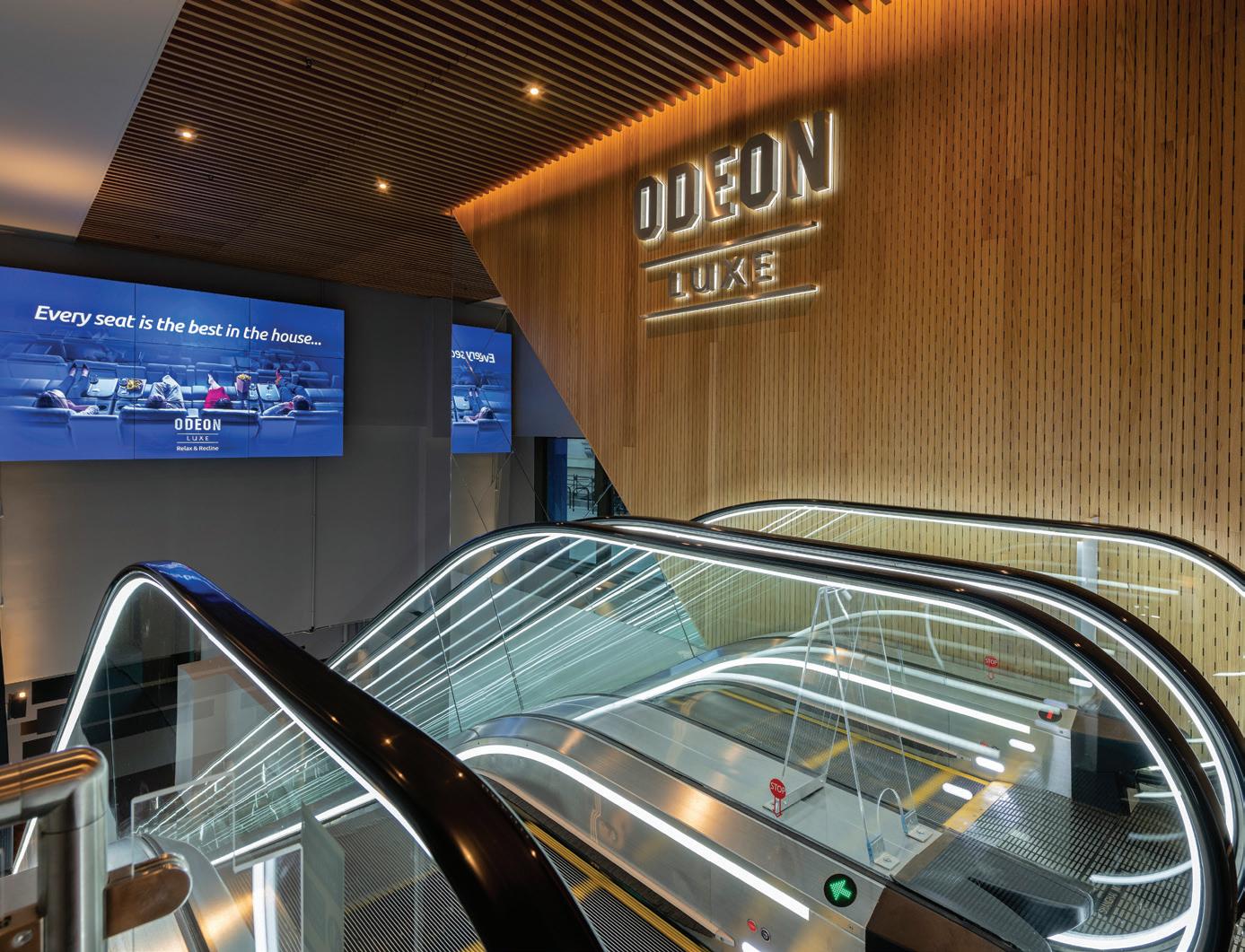
For a quarter of a century, Saturn Visual Solutions has been a key player in shaping the entire cinema experience, from the moment a patron approaches the cinema and their journey around the foyer and corridors, to the moment that they leave. Although the company started purely as a software provider, its focus has always been to serve its cinema clients’ needs and subsequently its offering has broadened substantially over time.
The first incarnation of Saturn’s content management software was in the late 1990s when ticket queues were long and inefficient. Cinemagoers weren’t easily able to see what showings were coming up or when, and could only find out what was available by asking box office staff when they reached the front of the queue. Saturn’s software allowed cinema operators to use their box
office information to automate updates and show film times on a screen without them having to input the information manually. Around the same time, screens and other hardware were incredibly expensive and bulky. Saturn’s software was developed to allowed cinemas to show a mixture of trailers, concessions information and promotional offers on a single screen in the foyer for the first time without having to make changes manually. It’s hard to imagine now, but these new abilities were a real game-changer for cinemas at the time.
Cinema clients began asking Saturn to supply and install hardware for them and it became so popular that it became a key part of the company’s offering. As such, Saturn was (and still is) constantly striving to learn more about technology and deliver the best service and prices possible. They were at the cutting edge as new innovations like self-
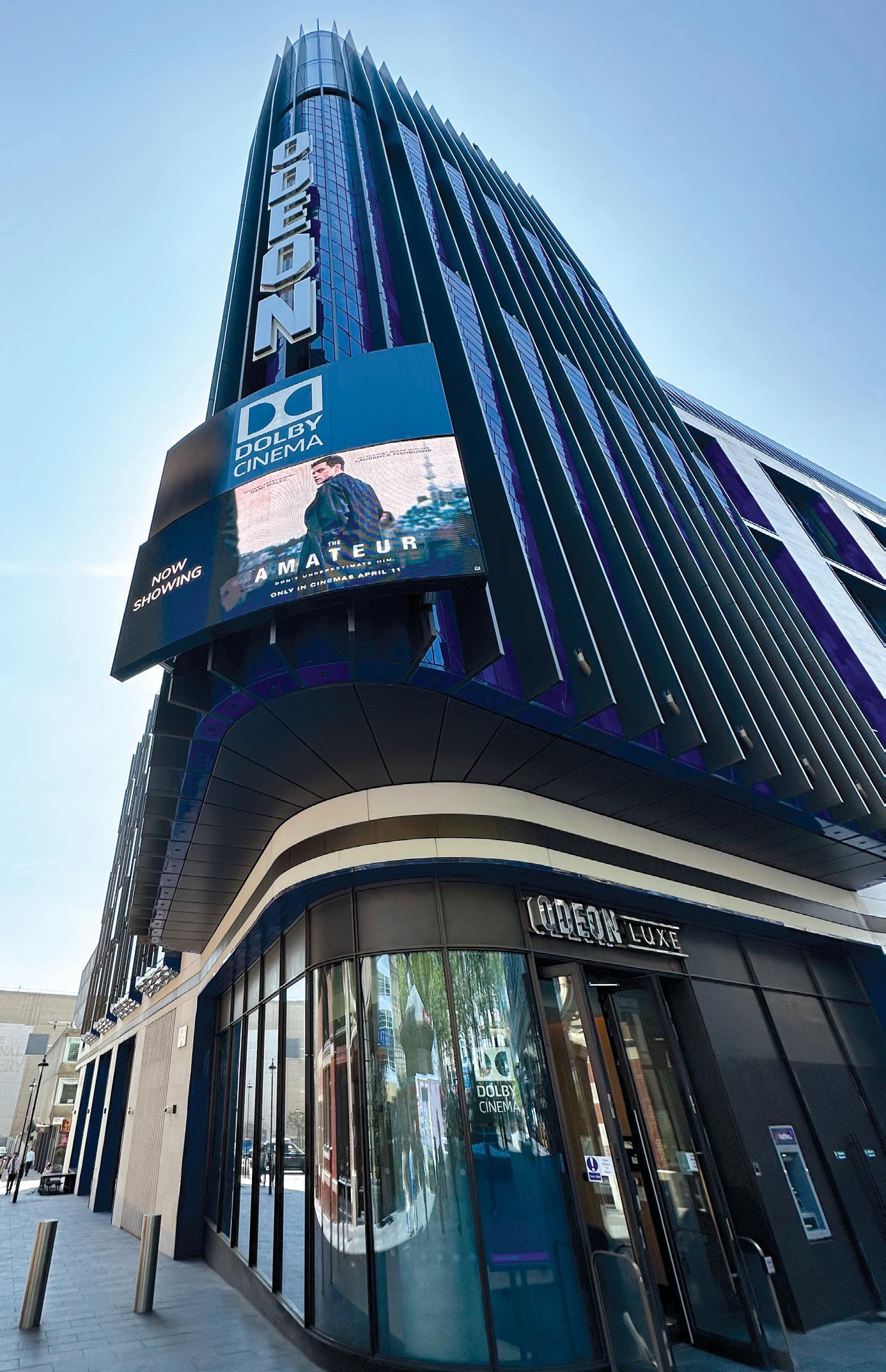
serve ticket kiosks became possible, allowing cinemas to use their staff’s time more efficiently.
Saturn continued to develop its software and in the 2010s gave cinemas the ability to use dayparting. This development meant that cinemas could now automatically change the content on screen at various times of day to target different types of audience with different trailers and
promotions. Customers could be targeted – both before and after the movies they’d come to see –with trailers for films of similar genre and ageclassification, thus creating a more personalised experience. Saturn’s software was also developed to use the cloud and to allow grouping. This meant that cinema chains could now manage all of their screens from one place, dividing them up into
Saturn has cultivated expertise and a strong affinity for the cinema industry over the past two and a half decades. This longevity has provided a solid foundation, built on years of experience and a keen understanding of the evolving needs of cinema operators, from independent theatres to large national chains.
Today, Saturn stands as a testament to the power of specialisation and a customercentric approach. Their deep-rooted experience within the UK cinema landscape has enabled them to develop a comprehensive suite of cost-effective services and solutions that directly address the challenges and opportunities faced by cinema operators. Having installed literally thousands of digital signage displays in cinemas over the years, Saturn has become adept at spotting where operational efficiency can be improved, how the F&B offering can be made more appealing, how the foyer experience can be made more fun, and generally how to encourage return visits. Saturn has subsequently developed a comprehensive suite of services to meet the cinemas’ needs. These services range from what you’d expect - hardware supply and installation, software licencing and technical support - to things that are a little more surprising. As part of its standard process, Saturn carries out a site assessment to review the customer journey within a cinema. Saturn will then make a series of recommendations which will include the types of digital signage displays that would perform best, and how they could be used to best effect based on the client’s priorities and specified budget. From this point, Saturn will project manage the installation of displays, indoors and outdoors, working with cinemas to minimise disruption. In contrast to most other digital signage agencies, Saturn offers content services so cinemas can have animated videos and still images that are designed and produced for them in their brand style, and sized for the displays they have. The content can take the form of menus with key items animated to draw attention to them. Alternatively, they could draw attention to loyalty schemes,
‘click and collect’ services, competitions, food and drink or merchandise promotions. Saturn can also produce ‘welcome’ content to create a positive first impression, highlight a cinema’s unique selling points, and create a distinction between it and other cinema brands.
Recognising the budgetary constraints of smaller cinema chains and independent venues, Saturn has used its economies of scale to develop affordable ‘pick and mix’ digital signage packages. These packages allow cinemas to pick a bundle of displays including menu boards, high bright window displays, video walls, outdoor displays, large screens, and selfservice ticket kiosks. In addition to hardware, the packages also include installation, software licensing and technical support, simplifying the process of purchase, installation and management for cinema operators. The flexible packages also include access to a library of content with preformatted trailers and approved concessions promotional materials for brands like Pepsi and Coca-Cola, making it much simpler for smaller cinema companies to create a great foyer experience that encourages F&B sales and return visits.
Screen enclosures and mounts are very effective in protecting hardware from damage. However, having seen first-hand how ‘off the shelf’ screen enclosures don’t work for every cinema client - either because the cinema’s architecture doesn’t lend itself well to the design, or because the cinema needs something that better complements their interior design - Saturn added a new offering to its suite of services - bespoke and off-the-shelf enclosures.
In addition to supplying, installing and maintaining digital signage, Saturn also offers a service to make displays ‘smarter’. It offers a software development service to integrate third party software/data with a content management software platform to show live information for things like ticket availability, timetables or prices. However, cinemas are now looking at expanding upon this service, for example, adding the ability to automatically remove promotional content from digital signage playlists if menu items are no longer in stock. Another exciting ‘smart display’ service
Saturn is offering, is the ability to use film timetables to automatically trigger digital signage displays to switch on and off in line with the first and last daily screenings, saving cinemas money on their energy bills.
Digital signage software makes it easy to build playlists, but to be able to interrupt the playlist and show something different would take around 5-10 minutes to set up. Saturn recognised the value in being able to switch content on demand and developed SaturnSelect. The solution, which is exclusive to Saturn, makes it easy to select/ switch content that’s showing on your digital signage, and choose which it appears on. For cinemas, this could allow customers relaxing in the foyer and waiting for a film to start to pick which trailers they want to watch. These selections can be tracked giving cinemas data on which movies their customers are most likely to want to watch. The time and date of these selections can also be tracked, giving cinemas an indication of the demographic of different customer trailer selections.
Saturn has also developed a gesturecontrolled digital signage offering, which allows cinemas to offer fun games in their foyer enhancing customer experience, or to generate customer feedback in a fun way.
The digital signage market is expanding rapidly and manufacturers are constantly innovating. There are a number of new types of digital signage hardware that are entering the market and Saturn has already starting to install some of them for clients.
Transparent LED walls are an innovative display technology that features an open, perforated design, enabling the viewer to see through the screen when it’s not displaying content. Unlike traditional LED screens, which are opaque, these panels use tiny LED modules with gaps in between, allowing natural light and views to pass through. This design creates a unique blend of digital content with the physical environment, making them ideal for settings where both aesthetics and functionality are valued.
Transparent LED walls offer cinemas an opportunity to convert their lobby or façade windows into displays. These displays can serve as dynamic, interactive canvases that add a futuristic look to the building while
inviting passers-by to get a glimpse of what’s available inside. For example, a cinema might install a transparent LED wall in its streetfacing glass windows to display promotions, ambient visuals or film trailers, all while allowing natural light and architectural features to remain visible, keeping a light and airy feel to the area inside. This integration can turn a standard cinema entrance into an exciting and immersive welcome area, creating a memorable first impression. Inside the cinema, transparent LED walls can be deployed as part of an immersive pre-show experience. They can be integrated into decorative installations, offering real-time event updates. Their inherent transparency means the screens won’t obstruct natural lighting or décor, contributing to an elegant interior environment. Furthermore, because of their lightweight design and robust technology, these LED panels are energyefficient, reducing operational costs while still delivering high-quality visuals. They are also difficult for thieves to target, as there is no obvious ‘unit’ to steal. Furthermore, at Integrated Systems Europe, the world’s premier AV and digital signage exhibition, another application for transparent displays waw unveiled. Fridge doors with transparent displays as doors. Unlike a transparent LED wall which uses a film, the fridge doors are made out of an actual digital display, and can be used to showcase the drink brands within the fridges, making them seem more appealing.
Another area of innovation is how existing technology can be applied differently. LED walls are now being positioned on the ceilings of buildings to create unique spaces that create more of an ‘experience’. The ceiling in The Printworks leisure destination in Manchester, UK contains Europe’s largest digital ceiling. It spans 1,000 square metres and features over 10 million pixels. The centre is free to enter and uses themed content and art exhibitions to transform the venue into a free, immersive attraction that draws visitors in irrespective of its core entertainment and hospitality offerings. Furthermore, it is now possible to use projection mapping to transform a floor into a fun, large-scale interactive space. This could be used by cinemas to create a fun immersive experience, for example, to simulate water, showing ripples as people walk across it. Alternatively, it could be used to play games, with customers using their feet to make selections.
regional groups and showing different content (e.g. different menu and promotional offer pricing) in different places.
In the late 2010s, LED technology started to emerge. Saturn was at the very forefront, learning about it and helping cinema clients to solve the reliability problems associated with video walls by helping them switch to LED walls. Whilst LED walls were more expensive to purchase and install, they were (and still are) more robust, energy efficient and last twice as long as video walls.
These giant, vibrant displays mean that cinema-goers can watch trailers from anywhere in the foyer area, and create a more exciting overall experience for cinema-goers.
Saturn’s software and comprehensive service offering has seen it build up an enviable client list over the years. As a result, the company now works with a range of cinema brands big and small including ODEON, Cineworld, Showcase, Reel Cinema, Scott Cinemas, and Movies@.
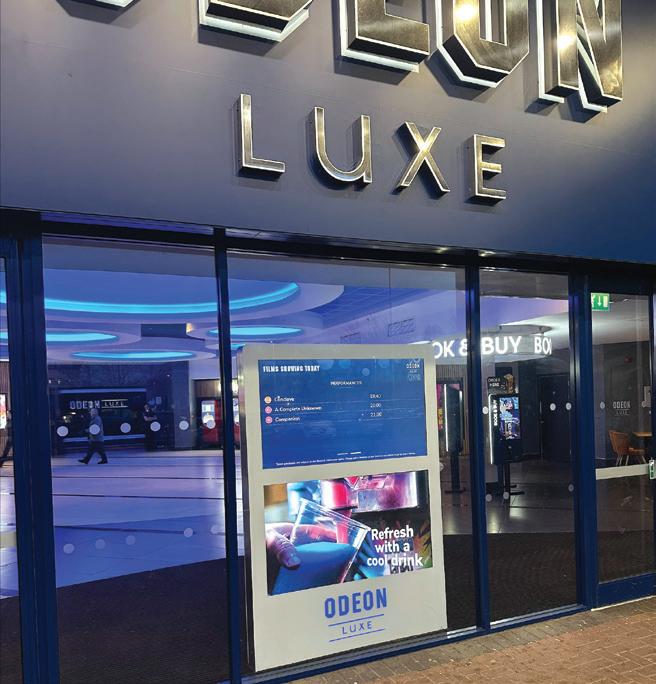
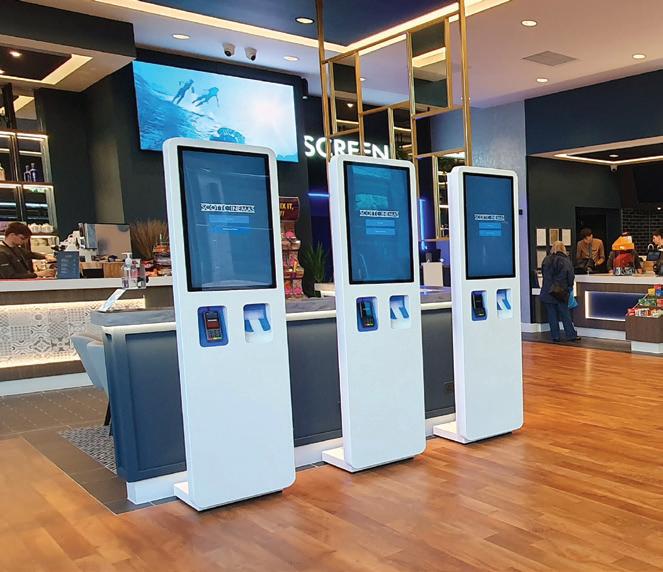

Since our company first began, we’ve been working with the cinema industry and helping our clients to respond to change use technology to improve their businesses. Cinemas have always welcomed change and the improvements it brings. However, what we’re now finding is that as the pace of change with technology speeds up, some cinemas are struggling to grasp its full potential. Technological advancements have given us almost unlimited potential to solve problems. For example, we have the capability to use existing data like film times to not only adjust what trailers appear on digital displays as customers are leaving so that they see trailers that are most likely to be of interest to them, we can also use that data to identify when areas of the cinema are at their quietest and automatically reduce the brightness of displays in corridors at those times to reduce energy bills.
For foyers with a good amount of natural light, we can use weather forecasts to identify when digital displays will need to be brighter so customers can easily see them, and when that brightness can be dialled down to save on energy costs with customers unaware of any discernible difference. Right now, cinemas have more challenges than ever to optimise their efficiency and profitability, but they also have more tools at hand than ever before to be able to do that.
I fully expect that in a few years there will be a split in the industry. Those that fully embrace technology and take advantage of what it can do for them and their customers, the efficiencies it can deliver, and how it can upgrade the ‘big screen experience’. And there will be those that don’t. As the pace of technological change continues apace, I would urge cinemas not to leave it too late to start exploring the possibilities.
